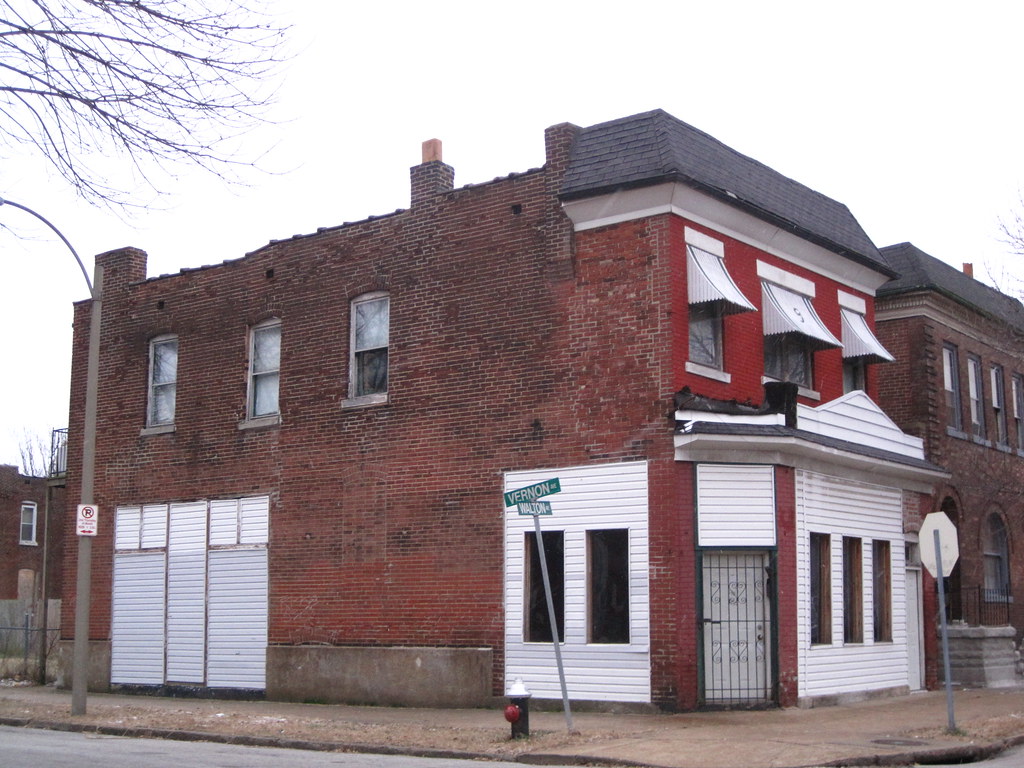Thursday, December 31, 2009
Bethany Deaf Church in Kirkwood Demolished
Kirkwood's local historic district ordinance did not prevent the new owner of the Bethany Deaf Church (photograph via link) at 310 E. Argonne from demolishing the building around Christmas. A reader writes that the wreckers destroyed the front doors rather than salvage them, but that the rose window may have been saved.
Labels:
churches,
demolition,
st louis county
Wednesday, December 30, 2009
International Design Competition Will Look at a Big Picture
The New Year will bring to St. Louis an international architectural competition centered on the Jefferson National Expansion Memorial. The only other such competition to take place in St. Louis also concerned the Memorial; in 1948, a competition selected for the Memorial the designed landscape of architect Eero Saarinen and landscape architect Dan Kiley. That selection gave a declining American river city a triumphant architectural boost and a place in postwar architectural history. The Gateway Arch designed by Saarinen became the internationally-recognized symbol of the city.
Will the new design competition lead to the implementation of a design as boldly modern as the Arch? Probably not. After all, the program for the competition is realization of the National Park Service's new General Management Plan (GMP) for the Memorial. That plan's preferred alternative is not a blueprint for radical upheaval of a significant landscape but a corrective program for finding remedies to that landscape's flaws. The new CityArchRiver 2015 Foundation, spearheaded by attorney Walter Metcalfe, Mayor Francis Slay, Memorial Superintendent Tom Bradley and national parks advocate Lynn McClure, is sponsoring the competition and raising money for implementation of the winning entry.
The competition thus wisely avoids a fruitless effort to construct a parallel icon near the Arch. The architectural genius of the Gateway Arch is elegant and unparalleled. Few contemporary architects -- or even starchitects with their tedious "signature" touches -- could match Saarinen's vision. Likewise, the Kiley landscape is a masterpiece. To attempt to add to the Memorial design through iconic design is folly. John Danforth's museum proposal was fueled by the incorrect assumption that any large new building on the Memorial grounds could be anything other than pretty clutter.
Still, the design competition is a clarion call for vision of a different kind. The GMP acknowledges the spatial obstacles to pedestrian access to the Memorial. In the GMP, there is discussion about the terrible infrastructure on the west and south sides of the Memorial that make pedestrian access difficult. The GMP discusses the moribund riverfront, the dormant east riverfront and other things that make the Memorial grounds a very divine landscape surrounded by an ugly cityscape and divided from urban vitality.
The design competition responds to the GMP by calling for radical reconceptualizing of the cityscape on both sides of the river that frame the Arch grounds. The subtitle of the competition is "Framing a Modern Masterpiece," indicating the challenge ahead: visionary urban place-making around a magnificent landscape that cuts across the boundaries of many government entities.
This competition thus is as much about politics as design. Mayor Francis Slay and Senator Claire McCaskill are deeply involved in the process. There is little doubt that the competition's fast track -- completion of improvements is slated for 2015 -- is driven by political concern rather than interest in truly transformative planning. In an interview, I asked competition manager Don Stastny of Stastny Brun if he had ever been involved in any design competition that had a time line of less than six years between the start of the competition and the projected completion of the design. He said that he had not, save a State Department competition for the destroyed Nairobi embassy.
There is a strong tension between the frank analysis offered by the National Park Service in the GMP and the "get it done" attitude of elected officials. Perhaps that tension is productive in a city that lacks any effective planning ordinance or agency. The National Park Service is playing the catalytic role that a city planning agency should already have done. On the other hand, without the competition's ambitious pace, good ideas might get lost or watered down through slow implementation. The competition process cuts through parochial politics by forcing St. Louis, East St. Louis, Missouri and Illinois to work together and implement solutions that are not neatly confined to parochial politics of appropriations.
Still, there is no need to have everything done by 2015. I like that early date as a spur to slow-moving local governments. However, I am afraid that date could preclude consideration of larger projects needed for connectivity. The competition cannot produce anything as great as the Memorial, but it need not be reigned in by a fixed, arbitrary timeline. After all, Kiley and Saarinen's plan was selected in 1948 but not fully completed until 1982.
Boundaries
 The boundaries of the competition are exciting, as the map above shows. There are several notable inclusions:
The boundaries of the competition are exciting, as the map above shows. There are several notable inclusions:
 If there has ever been the right time to consider removal of the depressed and elevated lanes, it is now. There is a great converegence between the design competition -- where thinking big is encouraged, and reweaving urban fabric is the foundation for the program -- and the 2016 opening of the new Mississippi River Bridge that will carry I-70 out of downtown forever. While the end dates of these projects don't align perfectly, they are too close to leave unexamined. Highway removal need not be underway in 2015 for the ribbon-cutting; if the competition jury endorses any plan for highway removal, the region will have made major progress.
If there has ever been the right time to consider removal of the depressed and elevated lanes, it is now. There is a great converegence between the design competition -- where thinking big is encouraged, and reweaving urban fabric is the foundation for the program -- and the 2016 opening of the new Mississippi River Bridge that will carry I-70 out of downtown forever. While the end dates of these projects don't align perfectly, they are too close to leave unexamined. Highway removal need not be underway in 2015 for the ribbon-cutting; if the competition jury endorses any plan for highway removal, the region will have made major progress.
 Obviously, the impact of the new bridge on traffic would need to be studied before removal could be planned. The replacement of I-70 should not be set in stone, since a wide boulevard could be as pedestrian-unfriendly as the current I-70/Memorial Drive configuration. Those two considerations are perfect fodder for a team of design professionals to engage. While we have the world's best architects working on solutions for the Memorial's connection to the rest of the city, we would be foolish to not encourage them to study one of downtown's biggest problems.
Obviously, the impact of the new bridge on traffic would need to be studied before removal could be planned. The replacement of I-70 should not be set in stone, since a wide boulevard could be as pedestrian-unfriendly as the current I-70/Memorial Drive configuration. Those two considerations are perfect fodder for a team of design professionals to engage. While we have the world's best architects working on solutions for the Memorial's connection to the rest of the city, we would be foolish to not encourage them to study one of downtown's biggest problems.
We have great leadership in the Memorial's Superintendent Bradley. Tom Bradley has been a patient, thoughtful and progressive player who has managed to channel converging political forces into a positive direction. Bradley weathered the Danforth museum idea, which did nothing to address the real planning issues of the Memorial, and forced normally complacent local leaders into action that has the potential to truly transform downtown. Stastny likewise should be a great manager, since his philosophy is that his clients must determine the choice to have a competition on their own. He's not a salesman, but an astute facilitator.
A successful competition will consider every entry on its merits, and its jurors will have the courage to endorse the best plan no matter what its political implications may be. We may never again see another international design competition in St. Louis. We must be as wise as our ancestors -- nay, wiser.
Will the new design competition lead to the implementation of a design as boldly modern as the Arch? Probably not. After all, the program for the competition is realization of the National Park Service's new General Management Plan (GMP) for the Memorial. That plan's preferred alternative is not a blueprint for radical upheaval of a significant landscape but a corrective program for finding remedies to that landscape's flaws. The new CityArchRiver 2015 Foundation, spearheaded by attorney Walter Metcalfe, Mayor Francis Slay, Memorial Superintendent Tom Bradley and national parks advocate Lynn McClure, is sponsoring the competition and raising money for implementation of the winning entry.
The competition thus wisely avoids a fruitless effort to construct a parallel icon near the Arch. The architectural genius of the Gateway Arch is elegant and unparalleled. Few contemporary architects -- or even starchitects with their tedious "signature" touches -- could match Saarinen's vision. Likewise, the Kiley landscape is a masterpiece. To attempt to add to the Memorial design through iconic design is folly. John Danforth's museum proposal was fueled by the incorrect assumption that any large new building on the Memorial grounds could be anything other than pretty clutter.
Still, the design competition is a clarion call for vision of a different kind. The GMP acknowledges the spatial obstacles to pedestrian access to the Memorial. In the GMP, there is discussion about the terrible infrastructure on the west and south sides of the Memorial that make pedestrian access difficult. The GMP discusses the moribund riverfront, the dormant east riverfront and other things that make the Memorial grounds a very divine landscape surrounded by an ugly cityscape and divided from urban vitality.
The design competition responds to the GMP by calling for radical reconceptualizing of the cityscape on both sides of the river that frame the Arch grounds. The subtitle of the competition is "Framing a Modern Masterpiece," indicating the challenge ahead: visionary urban place-making around a magnificent landscape that cuts across the boundaries of many government entities.
This competition thus is as much about politics as design. Mayor Francis Slay and Senator Claire McCaskill are deeply involved in the process. There is little doubt that the competition's fast track -- completion of improvements is slated for 2015 -- is driven by political concern rather than interest in truly transformative planning. In an interview, I asked competition manager Don Stastny of Stastny Brun if he had ever been involved in any design competition that had a time line of less than six years between the start of the competition and the projected completion of the design. He said that he had not, save a State Department competition for the destroyed Nairobi embassy.
There is a strong tension between the frank analysis offered by the National Park Service in the GMP and the "get it done" attitude of elected officials. Perhaps that tension is productive in a city that lacks any effective planning ordinance or agency. The National Park Service is playing the catalytic role that a city planning agency should already have done. On the other hand, without the competition's ambitious pace, good ideas might get lost or watered down through slow implementation. The competition process cuts through parochial politics by forcing St. Louis, East St. Louis, Missouri and Illinois to work together and implement solutions that are not neatly confined to parochial politics of appropriations.
Still, there is no need to have everything done by 2015. I like that early date as a spur to slow-moving local governments. However, I am afraid that date could preclude consideration of larger projects needed for connectivity. The competition cannot produce anything as great as the Memorial, but it need not be reigned in by a fixed, arbitrary timeline. After all, Kiley and Saarinen's plan was selected in 1948 but not fully completed until 1982.
Boundaries
 The boundaries of the competition are exciting, as the map above shows. There are several notable inclusions:
The boundaries of the competition are exciting, as the map above shows. There are several notable inclusions:- The east riverfront, a topic neglected in much of the recent debate on the Arch grounds, is included. In fact, a large part of Malcolm Martin Park is included. Unfortunately, the boundary excludes the Casino Queen site and the MetroLink station. The pedestrian path from Malcolm Martin Park to MetroLink should be included, since the walk currently takes place on an unkempt street without sidewalks.
- The boundary seems to purposely place both the Eads and Poplar Street bridges inside. The Poplar Street Bridge is aging and due for major overhaul. The competition could create a vision for what a new Poplar Street Bridge would look like. Bike and pedestrian lanes are a must.
- Kiener Plaza is included in the boundary. While the Old Courthouse is part of the Memorial and needs a more graceful frame than the current state of Kiener Plaza, does the plaza really need to be part of this process?
- All of the Memorial grounds are included, which is fine, but preservation of the landscape is essential. However, jurors in the competition -- and leaders of the CityArchRiver 2015 Foundation -- need to be ready to consider proposals that would reloctae or alter the north parking garage (operated by Metro) and the south maintenance facility.
- I-70 directly west of the Memorial is included, but the boundary does not extend north to capture all of the elevated section. The GMP states that the National Park Service "strongly supports" removal of the highway, but thinks it unfeasible at this time. Why?
 If there has ever been the right time to consider removal of the depressed and elevated lanes, it is now. There is a great converegence between the design competition -- where thinking big is encouraged, and reweaving urban fabric is the foundation for the program -- and the 2016 opening of the new Mississippi River Bridge that will carry I-70 out of downtown forever. While the end dates of these projects don't align perfectly, they are too close to leave unexamined. Highway removal need not be underway in 2015 for the ribbon-cutting; if the competition jury endorses any plan for highway removal, the region will have made major progress.
If there has ever been the right time to consider removal of the depressed and elevated lanes, it is now. There is a great converegence between the design competition -- where thinking big is encouraged, and reweaving urban fabric is the foundation for the program -- and the 2016 opening of the new Mississippi River Bridge that will carry I-70 out of downtown forever. While the end dates of these projects don't align perfectly, they are too close to leave unexamined. Highway removal need not be underway in 2015 for the ribbon-cutting; if the competition jury endorses any plan for highway removal, the region will have made major progress. Obviously, the impact of the new bridge on traffic would need to be studied before removal could be planned. The replacement of I-70 should not be set in stone, since a wide boulevard could be as pedestrian-unfriendly as the current I-70/Memorial Drive configuration. Those two considerations are perfect fodder for a team of design professionals to engage. While we have the world's best architects working on solutions for the Memorial's connection to the rest of the city, we would be foolish to not encourage them to study one of downtown's biggest problems.
Obviously, the impact of the new bridge on traffic would need to be studied before removal could be planned. The replacement of I-70 should not be set in stone, since a wide boulevard could be as pedestrian-unfriendly as the current I-70/Memorial Drive configuration. Those two considerations are perfect fodder for a team of design professionals to engage. While we have the world's best architects working on solutions for the Memorial's connection to the rest of the city, we would be foolish to not encourage them to study one of downtown's biggest problems.We have great leadership in the Memorial's Superintendent Bradley. Tom Bradley has been a patient, thoughtful and progressive player who has managed to channel converging political forces into a positive direction. Bradley weathered the Danforth museum idea, which did nothing to address the real planning issues of the Memorial, and forced normally complacent local leaders into action that has the potential to truly transform downtown. Stastny likewise should be a great manager, since his philosophy is that his clients must determine the choice to have a competition on their own. He's not a salesman, but an astute facilitator.
A successful competition will consider every entry on its merits, and its jurors will have the courage to endorse the best plan no matter what its political implications may be. We may never again see another international design competition in St. Louis. We must be as wise as our ancestors -- nay, wiser.
Labels:
downtown,
greenspace,
i-70 removal,
infrastructure,
jnem
Tuesday, December 29, 2009
Now It's Only "Northside Regeneration"
Blairmont is no more.
At least, Blairmont Associates LC and several other McEagle-controlled holding companies no longer exist. On December 14, Northside Regeneration LLC -- the public face of McEagle's NorthSide project -- filed two Notice of Merger statements with the Secretary of State.
The first of these merges all of McEagle's holding companies into Northside Regeneration: Blairmont, N & G Ventures LC, Noble Development Company LLC, VHS Partners LLC, PATH Enterprise Company LLC, Allston Alliance LC, Sheridan Place LC, Dodier Investors LLC, MLK 3000 LLC, Larmer LC and Union Martin LLC.
The second merges into Northside Regeneration all of the shell limited liability entities used to guarantee deeds of trust to the holding companies. That list is online at the Secretary of State's website.
At least, Blairmont Associates LC and several other McEagle-controlled holding companies no longer exist. On December 14, Northside Regeneration LLC -- the public face of McEagle's NorthSide project -- filed two Notice of Merger statements with the Secretary of State.
The first of these merges all of McEagle's holding companies into Northside Regeneration: Blairmont, N & G Ventures LC, Noble Development Company LLC, VHS Partners LLC, PATH Enterprise Company LLC, Allston Alliance LC, Sheridan Place LC, Dodier Investors LLC, MLK 3000 LLC, Larmer LC and Union Martin LLC.
The second merges into Northside Regeneration all of the shell limited liability entities used to guarantee deeds of trust to the holding companies. That list is online at the Secretary of State's website.
Monday, December 28, 2009
New Bethlehem Missionary Baptist Church Suffers Christmas Fire
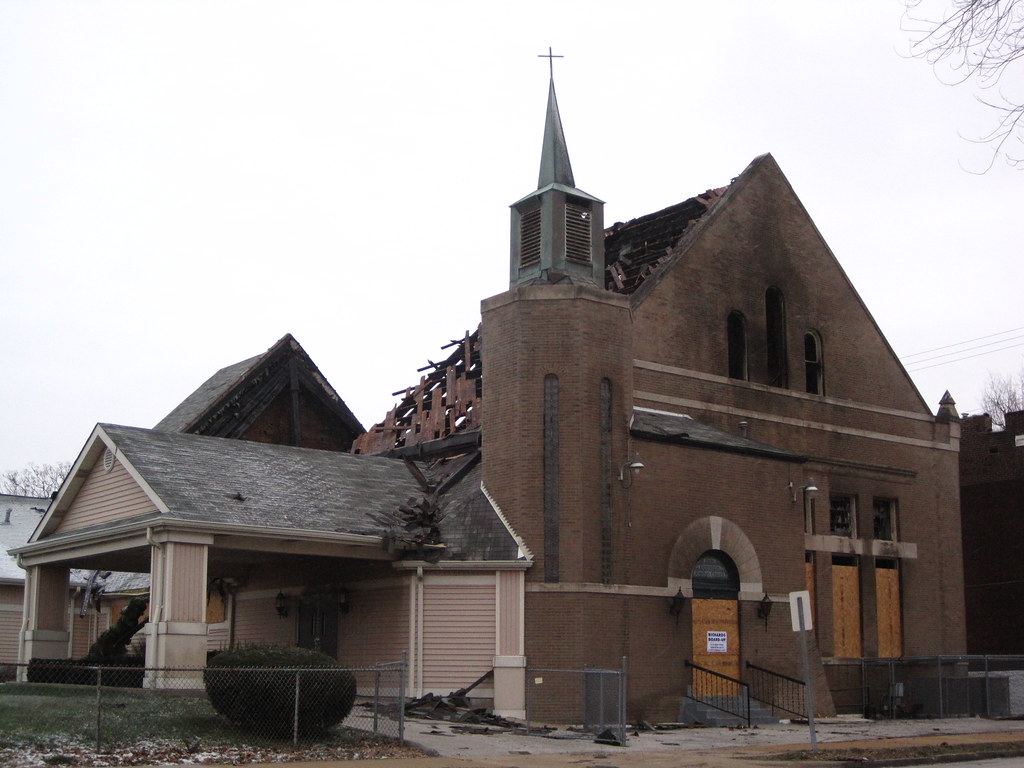 On Christmas, terrible tragedy struck the New Bethlehem Missionary Baptist Church in Fountain Park: the church caught fire and was severely damaged after the morning service. The Fire Department considers the four-alarm fire suspicious.
On Christmas, terrible tragedy struck the New Bethlehem Missionary Baptist Church in Fountain Park: the church caught fire and was severely damaged after the morning service. The Fire Department considers the four-alarm fire suspicious.Pastor Hosea Gales told the St. Louis Globe-Democrat that the church found a home for its Sunday service and that it will rebuild. What is uncertain is the fate of the historic church building at 1260 N. Euclid Avenue, built in the late 1890s as the Euclid Avenue Baptist Church. The preservation community should offer all possible assistance to the congregation.
Labels:
churches,
fire,
fountain park
Sunday, December 27, 2009
Old KFCs Are Buildings Too
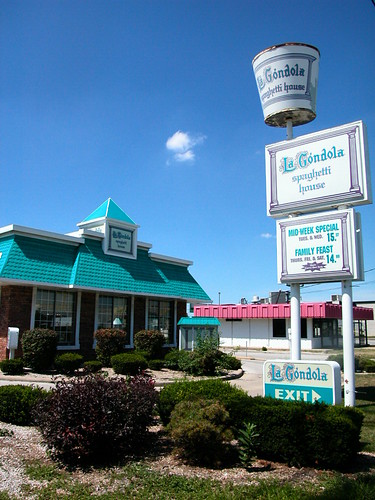 My wish for the New Year is simple: Let no vital structure go vacant or get demolished.
My wish for the New Year is simple: Let no vital structure go vacant or get demolished.Shown above is one of the countless road side examples of the infinite adaptability of even the ugliest American buildings. The La Gondola Restaurant at 2855 North Water Street in Decatur, Illinois is located in a former Kentucky Fried Chicken restaurant. La Gondola's rehab of the iconic fast food building consisted of new signage and repainting. Removal of the bucket of chicken was not on the agenda, and thus La Gondola has what may be the nation's only bucket of spaghetti sign.
I write "may" because the excellent website Not Fooling Anybody shows us that La Gondola's rehab of an old KFC is in the middle of fast food conversions, which range from inconspicuous total cover-up to oddities like the chiropractic office that retains a KFC bucket sign.
La Gondola is no stranger to converting fast food buildings: the La Gondola Restaurant in Galesburg is located in a converted Mr. Quick Hamburgers restaurant. La Gondola is a central Illinois chain that makes use of the cast-offs of another chain. That practice makes perfect sense, since smaller chains don't have the capital that a mega-chain like KFC does. La Gondola saves money, an old KFC doesn't sit vacant or get torn down and hungry Illinoisans still have a place to get a quick bite right where they used to.
The simple model of reuse practiced by La Gondola is not glamorous, but it works economically as well as ecologically. While an old KFC is not architecturally or urbanistically high-style, it's still a building made of shaped and processed natural resources. When reused, those resources are saved.
Labels:
adaptive reuse,
illinois
Saturday, December 26, 2009
Vintage Streetcar Photographs Show Mid-Century St. Louis
This week St. Louisan extraordinaire Jeff Vines discovered an online cache of 120 photographs of St. Louis Public Service Company trolley cars taken between 1954 and 1961. A few photographs from the 1980s are included.
The images of the cars in their vintage red, white and tan color scheme are fabulous. Yet the photographs also capture views of the city long lost, change or, in a few cases, preserved. The old Grand Avenue viaduct, its replacement soon to be replaced, features in many of the photographs in use adn under demolition. Other locations include the South Broadway car barn (now site of Carnahan Middle School), the Midtown skyline (remarkably unchanged), Maplewood, University City and Flynn Park, Washington Avenue from the Eads Bridge street car turn-around to 15th Street, rural Creve Couer, downtown St. Charles, and McKnight Road.
The photographs of the vicinity of the Eads Bridge and Washington Avenue include shots of the piers for the modern elevated lanes of I-70, now seen as likely to be removed in most of our life times.
The images of the cars in their vintage red, white and tan color scheme are fabulous. Yet the photographs also capture views of the city long lost, change or, in a few cases, preserved. The old Grand Avenue viaduct, its replacement soon to be replaced, features in many of the photographs in use adn under demolition. Other locations include the South Broadway car barn (now site of Carnahan Middle School), the Midtown skyline (remarkably unchanged), Maplewood, University City and Flynn Park, Washington Avenue from the Eads Bridge street car turn-around to 15th Street, rural Creve Couer, downtown St. Charles, and McKnight Road.
The photographs of the vicinity of the Eads Bridge and Washington Avenue include shots of the piers for the modern elevated lanes of I-70, now seen as likely to be removed in most of our life times.
Labels:
i-70 removal,
mass transit,
mid-century,
streets
Wednesday, December 23, 2009
Mid-Century Modern in the Hanley Industrial Court
I found myself in a situation that I normally avoid during the month of December (or any month, really): I had to go shopping at a store on Brentwood Boulevard. Coming from the southeast of my destination, I headed north on Hanley Road and decided to slip through the reliable Hanley Industrial Court short-cut.
Am I glad that I did! What I found brightened my day and made the otherwise excruciating experience worthwhile.
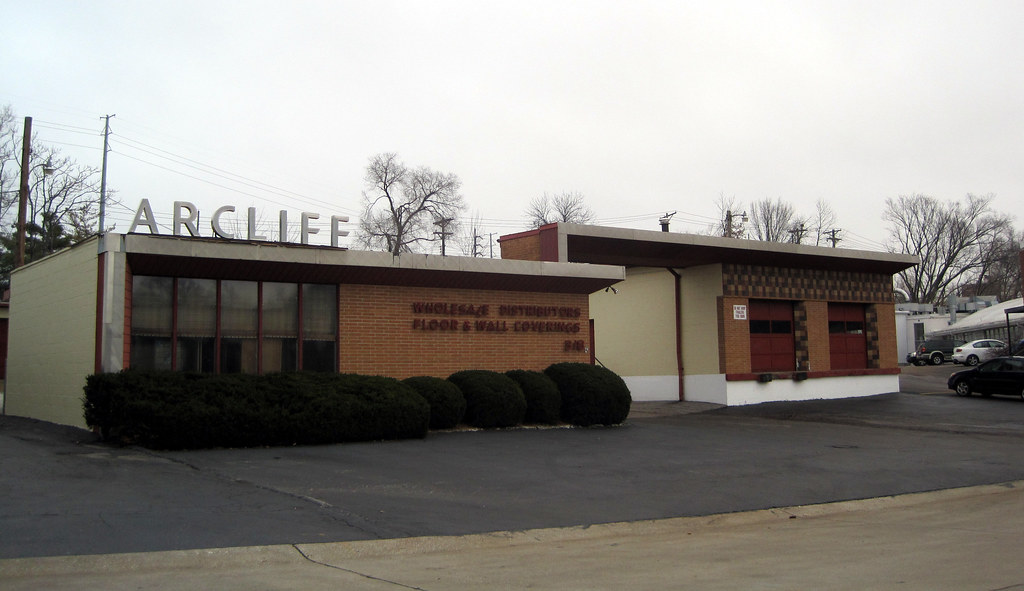 Voila, at 318 Hanely Industrial Court stands the home of Arcliff Wholesale Distributors. The mod building dates to 1960, and is in pristine condition down to the swanky metal letters above the roof life. The center is cut away, opening to an employee parking area that separates the showroom from the storeroom. The building's roofline changes to underscore the separation, creating welcome variation and presenting an almost Potemkin-like front to what is actually two very small sections and a lot of parking.
Voila, at 318 Hanely Industrial Court stands the home of Arcliff Wholesale Distributors. The mod building dates to 1960, and is in pristine condition down to the swanky metal letters above the roof life. The center is cut away, opening to an employee parking area that separates the showroom from the storeroom. The building's roofline changes to underscore the separation, creating welcome variation and presenting an almost Potemkin-like front to what is actually two very small sections and a lot of parking.
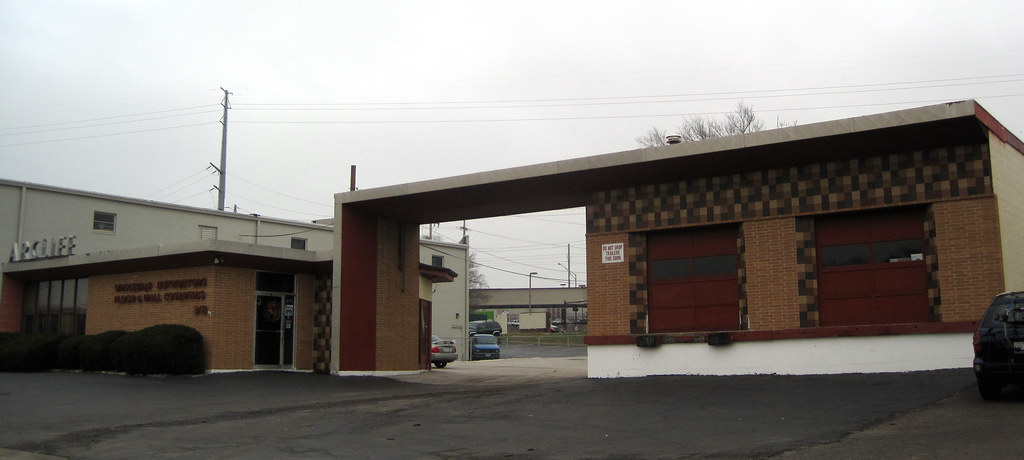 The storeroom section is accented with brown tile tapestry that underscores the tile sold wholesale by Arcliff. What a gem! Few of the other Hanley Industrial Court buildings demonstrate this much care in their design, so I was quite surprised to see this. I took a wrong turn to get there, so perhaps the serendipity was inevitable.
The storeroom section is accented with brown tile tapestry that underscores the tile sold wholesale by Arcliff. What a gem! Few of the other Hanley Industrial Court buildings demonstrate this much care in their design, so I was quite surprised to see this. I took a wrong turn to get there, so perhaps the serendipity was inevitable.
Am I glad that I did! What I found brightened my day and made the otherwise excruciating experience worthwhile.
 Voila, at 318 Hanely Industrial Court stands the home of Arcliff Wholesale Distributors. The mod building dates to 1960, and is in pristine condition down to the swanky metal letters above the roof life. The center is cut away, opening to an employee parking area that separates the showroom from the storeroom. The building's roofline changes to underscore the separation, creating welcome variation and presenting an almost Potemkin-like front to what is actually two very small sections and a lot of parking.
Voila, at 318 Hanely Industrial Court stands the home of Arcliff Wholesale Distributors. The mod building dates to 1960, and is in pristine condition down to the swanky metal letters above the roof life. The center is cut away, opening to an employee parking area that separates the showroom from the storeroom. The building's roofline changes to underscore the separation, creating welcome variation and presenting an almost Potemkin-like front to what is actually two very small sections and a lot of parking. The storeroom section is accented with brown tile tapestry that underscores the tile sold wholesale by Arcliff. What a gem! Few of the other Hanley Industrial Court buildings demonstrate this much care in their design, so I was quite surprised to see this. I took a wrong turn to get there, so perhaps the serendipity was inevitable.
The storeroom section is accented with brown tile tapestry that underscores the tile sold wholesale by Arcliff. What a gem! Few of the other Hanley Industrial Court buildings demonstrate this much care in their design, so I was quite surprised to see this. I took a wrong turn to get there, so perhaps the serendipity was inevitable.
Labels:
mid-century,
st louis county
Blogging and Action
Yesterday I was catching up on missed radio programs and listened to an interview with Alderman Antonio French (D-21st) that aired a few weeks ago on KDHX's "Collateral Damage". One statement stood out: Alderman French, whose Pub Def is one of St. Louis' trailblazing blogs and who is a local online media pioneer, doesn't have much time to read blogs. French says he's too busy doing his job to have the time needed to take in the local online media.
That's not surprising, actually, given how hard French is working for his ward. Yet French's statement reminds bloggers that our audiences often are not the decision-makers themselves but their constituents. If we want to spur action, we can't stay at the keyboard at call it a done deal. A blog is not a letter to a state senator, or testimony at a public meeting, or protest. Yet a blog can encourage people to take all of those acts -- and more.
As online media proliferates, the echo chamber effect can drown out the action potential of blogging. The Northside Regeneration topic is a great example of a case where the online chatter outweighs the real world action. I commend the activists who are doing the hard work of process participation on the issue, even though I don't agree with all of their tactics. The endangered buildings that come before the Preservation Board are another example where the online buzz often belies the fact that only one or two people will actually be present to testify -- or even observe -- the actual Board meeting.
Antonio French's remark on KDHX was not a big point, but it's an important one. Media doesn't solve the city's problems, although it helps identify them and encourages solution-making. Yet the solutions happen through our actions. We need both good blogging and effective political action, so that as the years go by we can measure the civic impact of early 21st century St. Louis activists in more than just word count.
That's not surprising, actually, given how hard French is working for his ward. Yet French's statement reminds bloggers that our audiences often are not the decision-makers themselves but their constituents. If we want to spur action, we can't stay at the keyboard at call it a done deal. A blog is not a letter to a state senator, or testimony at a public meeting, or protest. Yet a blog can encourage people to take all of those acts -- and more.
As online media proliferates, the echo chamber effect can drown out the action potential of blogging. The Northside Regeneration topic is a great example of a case where the online chatter outweighs the real world action. I commend the activists who are doing the hard work of process participation on the issue, even though I don't agree with all of their tactics. The endangered buildings that come before the Preservation Board are another example where the online buzz often belies the fact that only one or two people will actually be present to testify -- or even observe -- the actual Board meeting.
Antonio French's remark on KDHX was not a big point, but it's an important one. Media doesn't solve the city's problems, although it helps identify them and encourages solution-making. Yet the solutions happen through our actions. We need both good blogging and effective political action, so that as the years go by we can measure the civic impact of early 21st century St. Louis activists in more than just word count.
Tuesday, December 22, 2009
Year Ends for the Better in Two North St. Louis Commercial Districts
St. Louis Public Radio aired my latest commentary this morning. Listen to it here. The extended script follows.
This year ends with positive changes for two of north St. Louis' most distressed neighborhood commercial districts – the 14th Street district in Old North St. Louis and a section of Martin Luther King Drive in the Wellston Loop area.
In Old North, the $35 million Crown Square redevelopment project has transformed two blocks that once were the commercial center of the neighborhood. In 1977, using federal funds, the city of St. Louis closed the street to create a pedestrian mall. Eventually that mall killed the foot and vehicle traffic necessary to sustain the businesses.
Thankfully and improbably, most of the buildings fronting 14th Street on the two blocks between St. Louis and Warren streets survived abandonment. Now, these buildings have been beautifully rehabilitated into residential and commercial spaces. 14th Street is set to reopen to traffic early next year. Old North will regain a vital center.
The good news in the Martin Luther King Drive in the Wellston Loop area comes from an earlier chapter in the renewal story than the news from Old North. In November, a state review council approved a National Register of Historic Places nomination for 65 buildings on or around the north side thoroughfare from Clara Avenue west to the city limits.
The designation honors the cultural and architectural significance of what was in the late 1940s the city’s busiest shopping district. However, the designation also makes available rehabilitation tax credits long sought by building owners in the area. Such credits were crucial in rebuilding Crown Square.
Commercial districts are barometers of neighborhood health. Once they die, a neighborhood may be gone forever. By all indications, Old North and the Wellston Loop have a lot of life left in them.
This year ends with positive changes for two of north St. Louis' most distressed neighborhood commercial districts – the 14th Street district in Old North St. Louis and a section of Martin Luther King Drive in the Wellston Loop area.
In Old North, the $35 million Crown Square redevelopment project has transformed two blocks that once were the commercial center of the neighborhood. In 1977, using federal funds, the city of St. Louis closed the street to create a pedestrian mall. Eventually that mall killed the foot and vehicle traffic necessary to sustain the businesses.
Thankfully and improbably, most of the buildings fronting 14th Street on the two blocks between St. Louis and Warren streets survived abandonment. Now, these buildings have been beautifully rehabilitated into residential and commercial spaces. 14th Street is set to reopen to traffic early next year. Old North will regain a vital center.
The good news in the Martin Luther King Drive in the Wellston Loop area comes from an earlier chapter in the renewal story than the news from Old North. In November, a state review council approved a National Register of Historic Places nomination for 65 buildings on or around the north side thoroughfare from Clara Avenue west to the city limits.
The designation honors the cultural and architectural significance of what was in the late 1940s the city’s busiest shopping district. However, the designation also makes available rehabilitation tax credits long sought by building owners in the area. Such credits were crucial in rebuilding Crown Square.
Commercial districts are barometers of neighborhood health. Once they die, a neighborhood may be gone forever. By all indications, Old North and the Wellston Loop have a lot of life left in them.
Labels:
national register,
northside,
onsl,
wells-goodfellow
At the Preservation Board Yesterday
Carnival Supply Building to be Demolished
Yesterday, the St. Louis Preservation Board voted unanimously to permit demolition of the old St. Louis Carnival Supply Company building at 3928 S. Broadway (see "Old Carnival Supply Buildings Return to the Preservation Board", December 18. The motion to permit demolition made by David Richardson is conditional; owner KOBA LP must first obtain a building permit for facade improvements to the building at 3924 S. Broadway.
Alderman Ken Ortmann (D-9th) and the Chippewa-Broadway Business Association had previously opposed demolition of both buildings. At the meeting yesterday, Cultural Resources Office (CRO) Director Kate Shea announced that she had received letters of support for demolition of 3928 S. Broadway from both parties and that CRO was changing its position as well. Five residents of the Marine Villa neighborhood sent letters of opposition. I was the only person to testify against the demolition, following KOBA LP owner Ken Nuernberger (ordinarily a preservation-minded developer). As I told the Preservation Board, no matter what cladding covered 3928 S. Broadway and no matter what happens to the other building, the decision still was one between a historic corner commercial building and a surface parking lot.
A Row House By Any Other Standard...
Another matter before the Preservation Board was also of great interest. The owner of the house at 2248 Nebraska in the Fox Park Local Historic District wants to install aluminum windows on her home. CRO staff said they would have approved the windows, except that the house is part of an adjoined row of houses and that the windows would alter the character of the row. CRO recommended denial, but the Board voted unanimously to allow use of the windows. Richardson and Mary Johnson both stated that they believed that the local district standards applied to fee-simple houses and contained no language that enabled CRO to take into consideration neighboring buildings -- even if connected -- in making a decision about an individual permit.
Yesterday, the St. Louis Preservation Board voted unanimously to permit demolition of the old St. Louis Carnival Supply Company building at 3928 S. Broadway (see "Old Carnival Supply Buildings Return to the Preservation Board", December 18. The motion to permit demolition made by David Richardson is conditional; owner KOBA LP must first obtain a building permit for facade improvements to the building at 3924 S. Broadway.
Alderman Ken Ortmann (D-9th) and the Chippewa-Broadway Business Association had previously opposed demolition of both buildings. At the meeting yesterday, Cultural Resources Office (CRO) Director Kate Shea announced that she had received letters of support for demolition of 3928 S. Broadway from both parties and that CRO was changing its position as well. Five residents of the Marine Villa neighborhood sent letters of opposition. I was the only person to testify against the demolition, following KOBA LP owner Ken Nuernberger (ordinarily a preservation-minded developer). As I told the Preservation Board, no matter what cladding covered 3928 S. Broadway and no matter what happens to the other building, the decision still was one between a historic corner commercial building and a surface parking lot.
A Row House By Any Other Standard...
Another matter before the Preservation Board was also of great interest. The owner of the house at 2248 Nebraska in the Fox Park Local Historic District wants to install aluminum windows on her home. CRO staff said they would have approved the windows, except that the house is part of an adjoined row of houses and that the windows would alter the character of the row. CRO recommended denial, but the Board voted unanimously to allow use of the windows. Richardson and Mary Johnson both stated that they believed that the local district standards applied to fee-simple houses and contained no language that enabled CRO to take into consideration neighboring buildings -- even if connected -- in making a decision about an individual permit.
Labels:
demolition,
fox park,
marine villa,
preservation board,
southside
Monday, December 21, 2009
Marshall School Awaits New Use
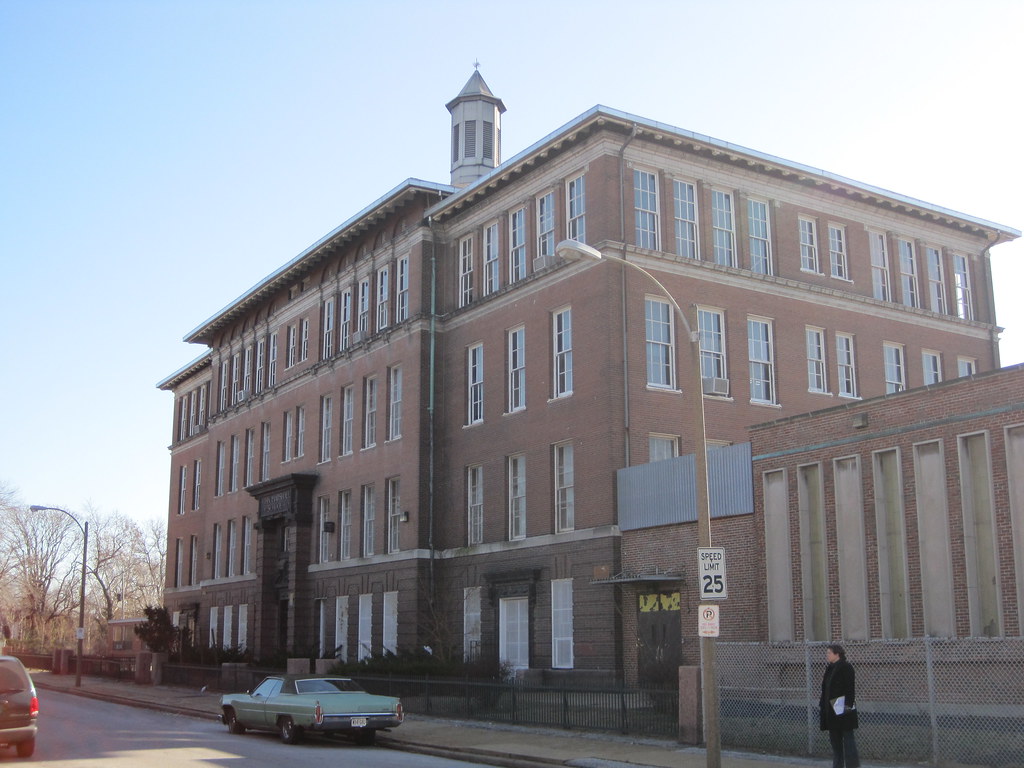 This week's news of a reprieve for Sumner High School brought relief to the Ville neighborhood, where another public school remains vacant after closing this summer. Stately John Marshall School stands at 4342 Aldine Avenue between Newstead and Pendleton avenues. The three-story building in the Classical Revival style dates to 1900 and is one of architect William B. Ittner's first uses of the E-Plan layout.
This week's news of a reprieve for Sumner High School brought relief to the Ville neighborhood, where another public school remains vacant after closing this summer. Stately John Marshall School stands at 4342 Aldine Avenue between Newstead and Pendleton avenues. The three-story building in the Classical Revival style dates to 1900 and is one of architect William B. Ittner's first uses of the E-Plan layout. The entrance is imposing and formed by brick piers supporting a massing terra cotta entablature. Brown terra cotta is used there and surrounding the doorway, over which a bust of John Marshall watches.
 Like Sumner, Marshall School is a crucial part of the cultural legacy of the Ville. During segregation, the school became an African-American intermediate school in 1918 and an elementary school in 1927. Many students who would pass through the doors of mighty Sumner High School, also designed by Ittner, would first pass through Marshall School.
Like Sumner, Marshall School is a crucial part of the cultural legacy of the Ville. During segregation, the school became an African-American intermediate school in 1918 and an elementary school in 1927. Many students who would pass through the doors of mighty Sumner High School, also designed by Ittner, would first pass through Marshall School.What future may be in store for the shuttered Marshall School is uncertain. With deed restrictions against charter school purchase lifted by the St. Louis Public Schools, educational use is possible. For now, however, all that is certain is that the Ville does not need another vacant school building.
Saturday, December 19, 2009
Winston Churchill Apartments
 One of the best preservation stories to come out of north St. Louis this year was the rehabilitation of the Winston Churchill Apartments at 5435-75 Cabanne Avenue in Visitation Park. The apartment building had long been the scourge of a changing neighborhood -- and not because it was a vacant eyesore. The Winston Churchill was fully occupied and generating as many as 300 calls to the police from neighbors before the apartments closed in 2005. In some cases, shutting down a nuisance property is only a trade between an occupied nuisance and a vacant one.
One of the best preservation stories to come out of north St. Louis this year was the rehabilitation of the Winston Churchill Apartments at 5435-75 Cabanne Avenue in Visitation Park. The apartment building had long been the scourge of a changing neighborhood -- and not because it was a vacant eyesore. The Winston Churchill was fully occupied and generating as many as 300 calls to the police from neighbors before the apartments closed in 2005. In some cases, shutting down a nuisance property is only a trade between an occupied nuisance and a vacant one.Because of the Friedman Group, Ltd. and Dublin Capital, the Winston Churchill instead was rejuvenated through a $12 million rehabilitation designed by Klitzing Welsch Architects and built out by E.M. Harris Construction Company. The building reopened with 101 affordable housing units. Many new houses have been built to the west of the Winston Churchill on Cabanne Avenue. Reopening the apartments ensures that the neighborhood offers housing to residents who are not in the market for owning a brand-new house or a large old home.
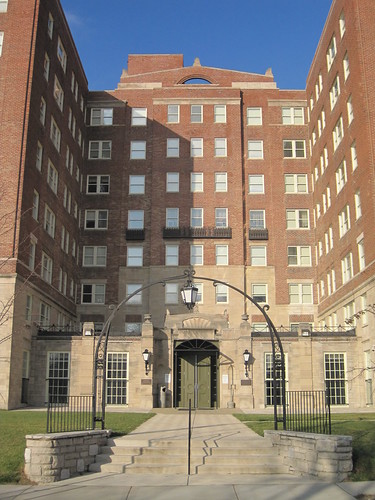 Built in 1927, the eight-story, concrete-framed Winston Churchill is an imposing, somewhat austere building. The brick architrave at the top is often mistaken for patchwork that replaced the original cornice, but the building never had any such cornice. The stark termination of the building is original (see two historic photographs here. The first two floors provide a softer neoclassical base clad in native Missouri limestone. The firm Avis, Hall and Proetz designed the apartment building, which is named for the once-renowned St. Louis novelist whose fame preceded that of the British statesman.
Built in 1927, the eight-story, concrete-framed Winston Churchill is an imposing, somewhat austere building. The brick architrave at the top is often mistaken for patchwork that replaced the original cornice, but the building never had any such cornice. The stark termination of the building is original (see two historic photographs here. The first two floors provide a softer neoclassical base clad in native Missouri limestone. The firm Avis, Hall and Proetz designed the apartment building, which is named for the once-renowned St. Louis novelist whose fame preceded that of the British statesman. At the time of construction, the Winston Churchill stood in the shadow of a more imposing building, the Visitation Academy by Barnett, Haynes and Barnett (1891) across the street. The eclectic French Renaissance Revival academy was the second St. Louis home of the school and convent of the Sisters of the Visitation, who had migrated to the city in 1844 following a devastating flood that destroyed their building in Kaskaskia, Illinois. The Sisters' tenure at Cabanne and Belt would last through 1962, when the order opened a new school and convent on Ballas Road in St. Louis County.
At the time of construction, the Winston Churchill stood in the shadow of a more imposing building, the Visitation Academy by Barnett, Haynes and Barnett (1891) across the street. The eclectic French Renaissance Revival academy was the second St. Louis home of the school and convent of the Sisters of the Visitation, who had migrated to the city in 1844 following a devastating flood that destroyed their building in Kaskaskia, Illinois. The Sisters' tenure at Cabanne and Belt would last through 1962, when the order opened a new school and convent on Ballas Road in St. Louis County.The building on Cabanne was demolished one year later, and the site donated to the City of St. Louis. The park is now knows as Ivory Perry Park, well-known for its summer concert series. The Winston Churchill Apartments is now the architectural anchor of the corner of Cabanne and Belt avenues, providing necessary housing as well as visual interest.
Labels:
historic preservation,
housing,
northside,
visitation park
Friday, December 18, 2009
Old Carnival Supply Buildings Return to the Preservation Board
 The two buildings at 3924 and 3928 South Broadway may look like a contrasting pair. One makes a robust display of unpainted, unaltered brick work that includes many patterns. The other building's front wall is covered in metal paneling, and its side elevation is caked in old paint. Separated by Alberta Avenue, these two buildings were the long-time home of St. Louis Carnival Supply.
The two buildings at 3924 and 3928 South Broadway may look like a contrasting pair. One makes a robust display of unpainted, unaltered brick work that includes many patterns. The other building's front wall is covered in metal paneling, and its side elevation is caked in old paint. Separated by Alberta Avenue, these two buildings were the long-time home of St. Louis Carnival Supply.Now, these corner anchors sit vacant. This summer, the present owner, KOBA LP, tried to persuade the city's Preservation Board to permit demolition of both buildings so that the owner could expand the parking lot of an adjacent strip mall where a Grace Hill clinic is located. In August, the Preservation Board voted to deny both demolitions on a preliminary basis. Now, KOBA LP returns with a proposal to demolish the metal-clad building and retain the other.
The city's Cultural Resources Office (CRO) does not accept the compromise. In a report to the Preservation Board for the Monday, December 21 meeting, the CRO recommends denial of both permits. CRO maintains that the metal-clad building is likely intact under the siding and its appearance could be restored. Furthermore, loss of the building would alter the nearly-intact Alberta Avenue street scape.

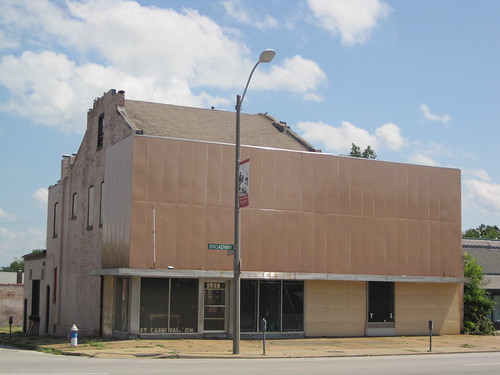
CRO is right. The building at 3924 S. Broadway is obviously worth rehabilitation, and the owner's earlier attempt to demolish it made no sense. However, the other building may be just as obvious a candidate for preservation once the metal siding is removed (an easy preliminary step). Perhaps KOBA LP will have evidence to dispel CRO's recommendation, but without removing the siding any argument merely will be a good guess.
The Preservation Board meets Monday, December 21 at 4:00 p.m. in the 12th floor conference room at 1015 Locust Street downtown. Testimony may be submitted via e-mail to Adona Buford at BufordA@stlouiscity.com.
Labels:
marine villa,
preservation board,
southside
Thursday, December 17, 2009
Good News from the Chatillon-DeMenil House: Roof Replacement on the Way
 Tonight, the Chatillon-DeMenil House Foundation hosted its Holiday Party and Annual meeting. The customary good cheer and fellowship always accompanies a short business meeting during which members of the Board of Directors are elected and news is shared. I was overjoyed to hear Board President Ted Atwood announce that the board is poised to sign a contract for roof replacement as soon as next week, and that restoration of the portico columns facing DeMenil Place will follow that project.
Tonight, the Chatillon-DeMenil House Foundation hosted its Holiday Party and Annual meeting. The customary good cheer and fellowship always accompanies a short business meeting during which members of the Board of Directors are elected and news is shared. I was overjoyed to hear Board President Ted Atwood announce that the board is poised to sign a contract for roof replacement as soon as next week, and that restoration of the portico columns facing DeMenil Place will follow that project. For the last few years, the condition of the roof and columns has caused concern among the many supporters of the house. Of course, the columns can't be repaired until the roof stops leaking. Next year, a new metal roof should be in place and column work underway.
If you have not been to the gift shop at the DeMenil, you will be in for a surprise. The shop has been overhauled. There is a strong new array of items for sale, and the room itself has been redecorated. It's much better!
The Chatillon-DeMenil House, located at 3352 DeMenil Place, is open Tuesday through Saturday, 10 a.m. - 4:00 p.m. One of the local preservation community's early success stories, the DeMenil was rescued in 1964 from the path of interstate highway 55 by Landmarks Association of St. Louis using a generous gift from Union Electric Company. If you go for a tour during the week, there is a great chance that Facilities Director Kevin O'Neill will give you the tour. Kevin's knowledge and stewardship are amazing, and one of the reasons the DeMenil is no ordinary house museum.
Labels:
benton park,
historic preservation,
southside
Good News and Bad News on Page Boulevard
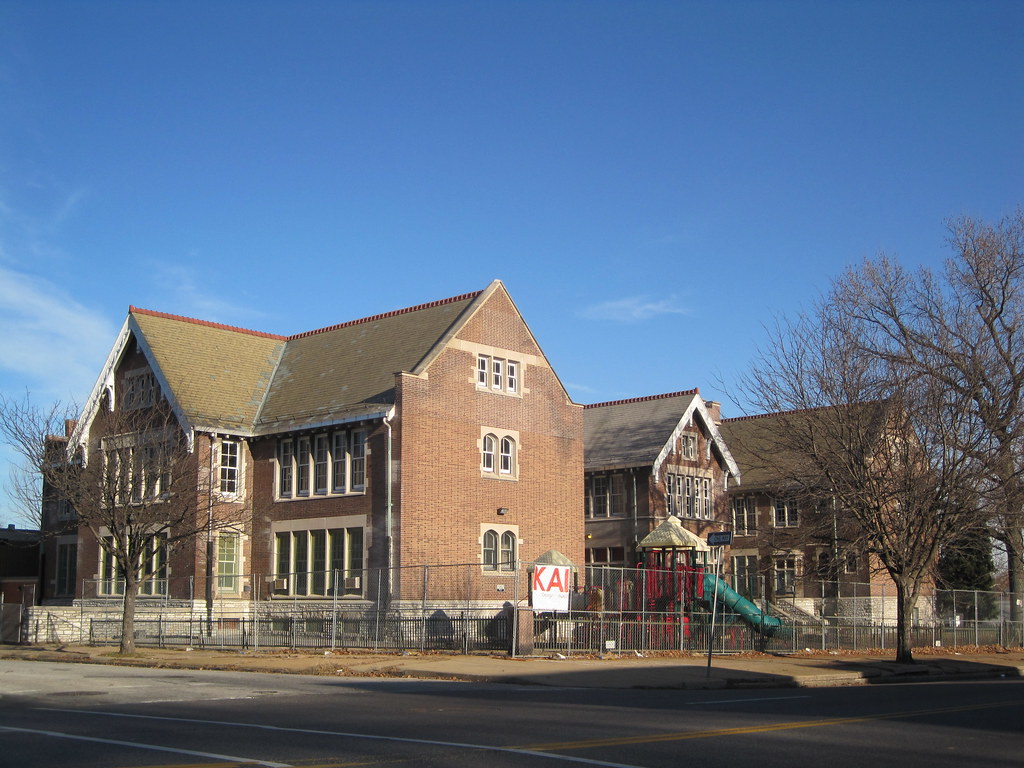 Preservationists should send their thanks to Better Family Life, a cultural and educational organization that is uplifting African-American St. Louis while rehabilitating one of our city's irreplaceable historic schools. In 2005, Better Family Life purchased the shuttered Ralph Waldo Emerson School at 5415 Page Boulevard. This year, the organization began a $4.5 million rehabilitation that will convert the school into an educational and cultural center.
Preservationists should send their thanks to Better Family Life, a cultural and educational organization that is uplifting African-American St. Louis while rehabilitating one of our city's irreplaceable historic schools. In 2005, Better Family Life purchased the shuttered Ralph Waldo Emerson School at 5415 Page Boulevard. This year, the organization began a $4.5 million rehabilitation that will convert the school into an educational and cultural center.Currently, a construction fence surrounds the school. Workers are on site most days, and a lift was in front today. The daily activity at Emerson School has not been this high since the school's last day of classes in June 2003. When the school closed, few predicted that any serious buyer would step forward so soon. The landmark could have become an abandoned wreck.
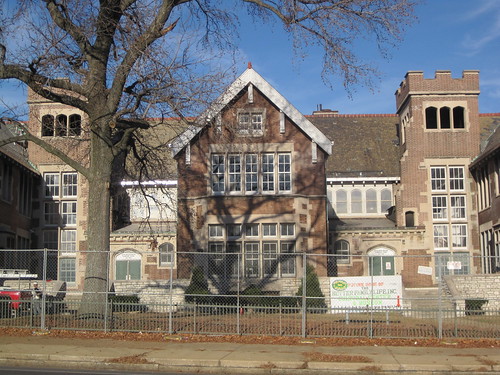 Designed by William B. Ittner and completed in 1901, the brick school is one of the earliest of Ittner's schools in the hybrid "Jacobethan" style that he helped popularize. Ittner began working for the St. Louis Board of Education in 1898, and did not turn to the Renaissance styles until a few years into his tenure. Emerson School is a handsome early work utilizing the architect's open floor plan. The grace of the landmark shall be with us for generations, thanks to Better Family Life.
Designed by William B. Ittner and completed in 1901, the brick school is one of the earliest of Ittner's schools in the hybrid "Jacobethan" style that he helped popularize. Ittner began working for the St. Louis Board of Education in 1898, and did not turn to the Renaissance styles until a few years into his tenure. Emerson School is a handsome early work utilizing the architect's open floor plan. The grace of the landmark shall be with us for generations, thanks to Better Family Life.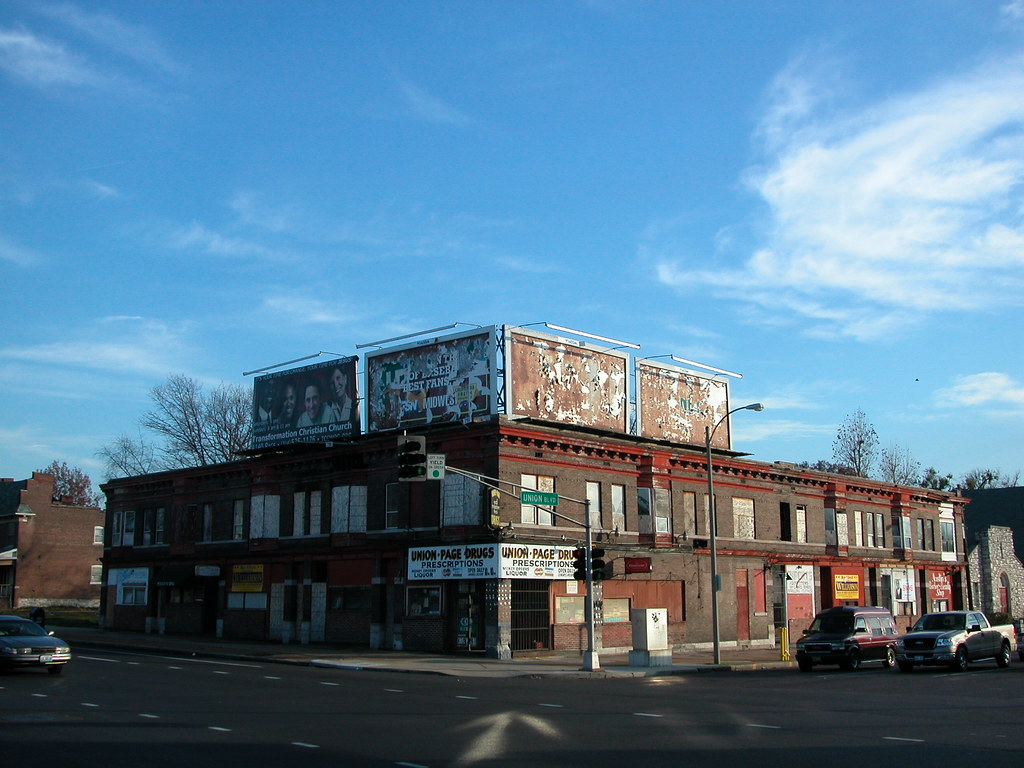 If only all good news from St. Louis' built environment did not have to be counterbalanced by bad news. Just two blocks east of Emerson on the south side of mighty Page Boulevard at Union Boulevards, another north side landmark is meeting a sad end. The corner commercial block at 5986-98 Page Boulevard, written about on this blog several times before, is finally falling to the wreckers. I offer here an image of the building in better days, and will spare readers yet another demolition photograph.
If only all good news from St. Louis' built environment did not have to be counterbalanced by bad news. Just two blocks east of Emerson on the south side of mighty Page Boulevard at Union Boulevards, another north side landmark is meeting a sad end. The corner commercial block at 5986-98 Page Boulevard, written about on this blog several times before, is finally falling to the wreckers. I offer here an image of the building in better days, and will spare readers yet another demolition photograph.The corner building is a younger building than Emerson School, with a completion date at 1905. The two-story building is part of the Mount Cabanne-Raymond Place Historic District and could have been reused utilizing historic tax credit programs. Surely, commercial storefronts and apartments enjoy far more demand in the city than cultural centers. However, the building had the wrong owner, the Berean Seventh Day Adventist Church, which will be building a parking lot on the site.
In February 2008, the city's Preservation Board voted 5-2 to deny a demolition permit for this building. Then, in June 2009, the city's Planning Commission arbitrarily overturned the Preservation Board decision (see "Planning Commission Overturns Two Preservation Board Decisions", June 19).
The story got stranger after that when the church failed to meet the requirements of the Planning Commission decision but began demolition this summer without a permit. City officials called a halt to the wrecking, but the wreckers had already delivered fatal damage by removing most of the roof. Now the rest of the building will be removed legally. Page Boulevard will have a completely disjointed, unhinged intersection with Union Boulevard. Two prominent thoroughfares shall meet at an intersection as full of character as any generic suburban intersection anywhere in the United States. This city, it should be stated, deserves better. It deserves what it had before.
Labels:
academy neighborhood,
demolition,
northside,
preservation board,
schools,
slps
Tuesday, December 15, 2009
Cash for Caulkers: What About Cash for Weatherstrippers?
Today President Barack Obama spoke in favor of an energy efficiency program dubbed "Cash for Caulkers."
Where did this speech take place? Outside of a Home Depot store in Virginia. Not a good sign. Where does the program leave the millions of Americans who resident in historic houses?
We aren't sure yet. The Climate Change bills that stalled in the House and Senate actually included a bikk called Retrofit for Energy and Environmental Performance (REEP) that provided specific incentives for achieving energy efficiency in historic buildings.
The new administration program should carry over language that allows historic building owners to get incentives for making more sensitive and effective repairs to their buildings. Home Depot is a fine place to buy caulk, but it is also fairly useless to someone who wants to retain and repair a wooden window made from 125-year-old virgin growth timber.
If the new incentive would reward someone for removing a window that could be as old as a century and replace it with a window that probably won't last 20 years, but won't reward someone for retaining and repairing existing windows, then it should be called "Cash for Home Depot." Removal of existing building material that can be saved is a waste of natural resources. Replacement of that material with materials designed to last less than two decades increases one's carbon footprint in the long run.
Historic windows are often the first things to be removed in a rehabilitation project. They almost never get replaced with anything that will have the same durability or longevity. A wooden window can be maintained for well over a century, and can be kept weather-tight with proper glazing, weatherstripping and the presence of an interior or exterior storm window. The thermal properties of wood are actually quite good, especially when that wood has the dense grains found in the old-growth wood available to builders in the 19th and early 20th century. Your windows are second-nature natural resources, and their destruction has an environmental impact no matter how "energy efficient" contemporary windows' manufacturers claim they can be.
Scratching your head at my logic? I offer a Energy Efficiency Tips for Historic Homeowners, a document published by the City of Albany, New York. There is also a short article by architect Curtis Drake entitled "Making Your Historic Home More Energy Efficient" that appeared in Save Our Heritage Organisation Magazine.
Hopefully President Obama will support an energy efficiency program that makes sense for all buildings and all remedies -- even those that can't be purchased at the Big Orange Box.
Where did this speech take place? Outside of a Home Depot store in Virginia. Not a good sign. Where does the program leave the millions of Americans who resident in historic houses?
We aren't sure yet. The Climate Change bills that stalled in the House and Senate actually included a bikk called Retrofit for Energy and Environmental Performance (REEP) that provided specific incentives for achieving energy efficiency in historic buildings.
The new administration program should carry over language that allows historic building owners to get incentives for making more sensitive and effective repairs to their buildings. Home Depot is a fine place to buy caulk, but it is also fairly useless to someone who wants to retain and repair a wooden window made from 125-year-old virgin growth timber.
If the new incentive would reward someone for removing a window that could be as old as a century and replace it with a window that probably won't last 20 years, but won't reward someone for retaining and repairing existing windows, then it should be called "Cash for Home Depot." Removal of existing building material that can be saved is a waste of natural resources. Replacement of that material with materials designed to last less than two decades increases one's carbon footprint in the long run.
Historic windows are often the first things to be removed in a rehabilitation project. They almost never get replaced with anything that will have the same durability or longevity. A wooden window can be maintained for well over a century, and can be kept weather-tight with proper glazing, weatherstripping and the presence of an interior or exterior storm window. The thermal properties of wood are actually quite good, especially when that wood has the dense grains found in the old-growth wood available to builders in the 19th and early 20th century. Your windows are second-nature natural resources, and their destruction has an environmental impact no matter how "energy efficient" contemporary windows' manufacturers claim they can be.
Scratching your head at my logic? I offer a Energy Efficiency Tips for Historic Homeowners, a document published by the City of Albany, New York. There is also a short article by architect Curtis Drake entitled "Making Your Historic Home More Energy Efficient" that appeared in Save Our Heritage Organisation Magazine.
Hopefully President Obama will support an energy efficiency program that makes sense for all buildings and all remedies -- even those that can't be purchased at the Big Orange Box.
Labels:
historic preservation,
public policy
Sunday, December 13, 2009
Board Up Award
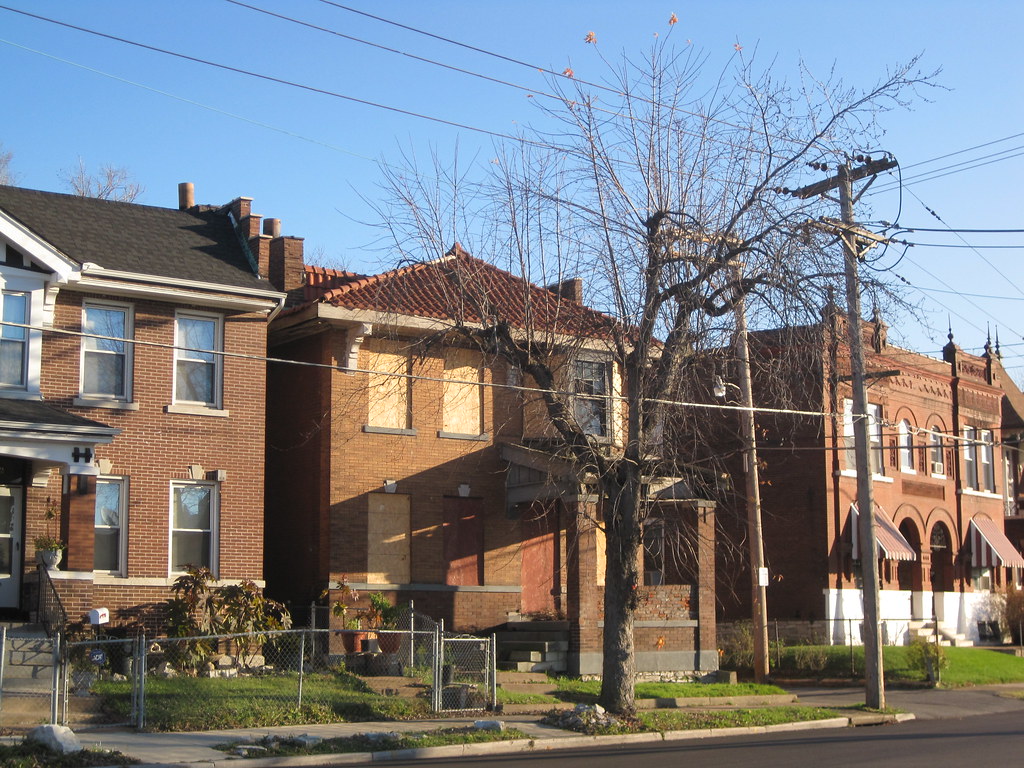 And the award for boarding up almost every window on a front elevation of an abandoned north St. Louis house surrounded by occupied houses goes to: Urban Assets LLC, for 1414 N. Euclid Avenue in Fountain Park!
And the award for boarding up almost every window on a front elevation of an abandoned north St. Louis house surrounded by occupied houses goes to: Urban Assets LLC, for 1414 N. Euclid Avenue in Fountain Park!
Labels:
fountain park,
northside,
urban assets
Saturday, December 12, 2009
West Cabanne Place Living
The city's West Cabanne Place opened in 1888 as a semi-rural private street, located away from the urban core of St. Louis. Many prominent businessmen and a few architects -- including Charles Ramsey and Theodore Link -- purchased lots and built large homes on West Cabanne. Built in 1889 for E.O. Pope of the Jones-Pope Produce Company, the house at 5927 West Cabanne was one of the earliest residences on the street. The designer of the eclectic home remains unknown. Jane Porter, author of the National Register of Historic Places nomination for West Cabanne Place, suggests that a contractor rather than an architect designed the Italianate-influenced house, which mixes elements rather freely.
 In the 1990s, 5927 West Cabanne Place appeared to be at risk of being lost. Landmarks Association of St. Louis included in the house in its annual Eleven Most Endangered Places list for several years. Eventually, however, the home fell into the hands of an owner who gave the house needed rehabilitation work. The exterior was restored by removing asphalt siding and repairing and replacing wooden elements. Now the spacious residence is for sale for the unbelievable price of $119,000. This truly must be a buyer's market, for a rehabilitated home on West Cabanne Place to be offered at that price!
In the 1990s, 5927 West Cabanne Place appeared to be at risk of being lost. Landmarks Association of St. Louis included in the house in its annual Eleven Most Endangered Places list for several years. Eventually, however, the home fell into the hands of an owner who gave the house needed rehabilitation work. The exterior was restored by removing asphalt siding and repairing and replacing wooden elements. Now the spacious residence is for sale for the unbelievable price of $119,000. This truly must be a buyer's market, for a rehabilitated home on West Cabanne Place to be offered at that price!
Labels:
historic preservation,
northside,
rehabbing,
west end
Second Anti-Wrecking Ball: Success
Toby Weiss has already posted an excellent recap of last night's Anti-Wrecking Ball, but here's another. In short, we raised more money than we thought that we could, had more people attend than we expected and had a lot more dancing than usually seen at preservation fundraisers!
Video by Toby Weiss.
Dozens of people came to Old North St. Louis to support the cause of citizen preservation action and to enjoy a party inside of the spacious, lovely new Old North St. Louis Community Gallery. The venue was perfect, and not simply spatially. While the event's focus was raising money for the Friends of the San Luis' appeal of a circuit court ruling against citizen standing in preservation battles, it was also a celebration of all that we can do together. The gallery is smack dab in the middle of the revitalized 14th Street commercial district, until recently a horrid pedestrian mall. The rebirth of the mall and Old North have come through the dedication of scores of people working against tough odds. Citizens, acting on the belief that we can make our neighborhoods better places and save our irreplaceable landmarks.
The attendance was a great example of the wide support for preservation. There were north side residents, young urbanists, veteran preservationists, architects, artists, anti-eminent domain activists, and even a Preservation Board member. Up the street at the Urban Studio Cafe there was an art opening, and crowds migrated back and forth throughout the evening.
DJ Darren Snow kept a wonderful flow of music going. Emily Beck created a powerful slide show that weaved together the past year of Friends of the San Luis events, architectural images and photographs of people across the city celebrating the historic architecture of our neighborhoods. The Chase Park Plaza Cinemas, STL Style and Toby and I provided raffle items. Volunteers too numerous to mention pitched in, and the party went well past the advertised midnight close. Bravo!
Video by Toby Weiss.
Dozens of people came to Old North St. Louis to support the cause of citizen preservation action and to enjoy a party inside of the spacious, lovely new Old North St. Louis Community Gallery. The venue was perfect, and not simply spatially. While the event's focus was raising money for the Friends of the San Luis' appeal of a circuit court ruling against citizen standing in preservation battles, it was also a celebration of all that we can do together. The gallery is smack dab in the middle of the revitalized 14th Street commercial district, until recently a horrid pedestrian mall. The rebirth of the mall and Old North have come through the dedication of scores of people working against tough odds. Citizens, acting on the belief that we can make our neighborhoods better places and save our irreplaceable landmarks.
The attendance was a great example of the wide support for preservation. There were north side residents, young urbanists, veteran preservationists, architects, artists, anti-eminent domain activists, and even a Preservation Board member. Up the street at the Urban Studio Cafe there was an art opening, and crowds migrated back and forth throughout the evening.
DJ Darren Snow kept a wonderful flow of music going. Emily Beck created a powerful slide show that weaved together the past year of Friends of the San Luis events, architectural images and photographs of people across the city celebrating the historic architecture of our neighborhoods. The Chase Park Plaza Cinemas, STL Style and Toby and I provided raffle items. Volunteers too numerous to mention pitched in, and the party went well past the advertised midnight close. Bravo!
Labels:
events,
historic preservation,
northside,
onsl
Tuesday, December 8, 2009
More Time Needed to Market Belleville YMCA Building
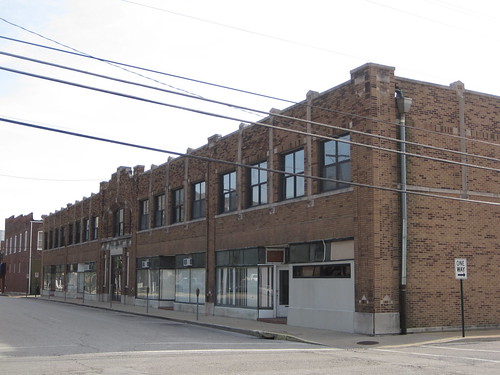
On December 5, the Belleville News Democrat carried an article with the title "Reality check for old YMCA building: 'Unless money is found, nothing's going to happen'". The article contains disturbing news from Belleville's effort to market the historic downtown YMCA building, originally the Belleville Turner Hall (see ""Old Belleville Turner Hall Could Be Yours", August 7, 2009). From the article:
Jack LeChien, alderman in Ward 7 and the chairman of the YMCA committee, has favored using the building rather than tearing it down; after all, he's a member of the Belleville Historic Preservation Commission. But he thinks anyone with a strong proposal and adequate financial backing likely would have stepped forward by now.
Alderman LeChien had had a tough job, and has done it well. LeChien reached out to historic preservation blogs, magazines and other publications to carry the Request for Proposals issued by the city. However, the timing of Belleville's quest to sell the YMCA building has been a problem. Belleville picked the worst possible time for developers to get financing for a large project like the YMCA building. As I wrote to Alderman LeChien in June: "One thing to consider is that the lending climate is still emerging from stagnation and many developers who might be interested could need time to close on financing."
The fact is that the market is still slow and recovery is not complete. Belleville needs more time to sell the YMCA building, and its leaders should not rush to any conclusions about lack of responses to the RFP.
Also, the RFP posted on Belleville's website this year was not very strong. The document consisted of a short cover statement and a lengthy report on asbestos issues -- not a great marketing package. All old buildings have some asbestos, but not all old buildings have the reuse potential, location and cool interior spaces that the Bellevilel YMCA has. More time and a better RFP are needed.
Labels:
belleville,
historic preservation
International Design Competition to Invigorate the Gateway Arch Starts Today
Goal is to "Frame a Modern Masterpiece" and Connect the Gateway Arch with the Mississippi River and the St. Louis Region by 2015
FOR RELEASE: December 8, 2009
Contact: Tom Bradley, Superintendent
Jefferson National Expansion Memorial
(314) 655-1600
Jeff Rainford
Office of St. Louis Mayor Francis G. Slay
(314) 622-3201
ST. LOUIS, Mo. – The National Park Service and St. Louis Mayor Francis Slay today launched an international design competition to invigorate the park and city areas surrounding of one of the world’s most iconic monuments, the Gateway Arch in St. Louis.
"The competition begins today," said Tom Bradley, Superintendent of the Jefferson National Expansion Memorial, which includes the Gateway Arch. "This competition is a unique and important opportunity to integrate the Arch and the park surrounding it into the fabric of the city and region and embrace the Mississippi River and its east bank. It's an opportunity to energize the park with new amenities and attractions. By achieving these objectives, we will design people into the area – and establish a national model for urban parks."
The winning design will be announced in October 2010, with the resulting work completed by October 28, 2015 – the 50th anniversary of the completion of the Arch.
"Critical stakeholders are engaged and the architectural and design communities are excited to get started," said Slay, who, with Bradley, is a member of the CityArchRiver2015 Foundation, a nonprofit organization created to drive the effort. Also represented in that group are regional business and university leaders, national park advocates and architects.
"We're very lucky to now have Tom Bradley as a partner in this initiative," said Slay. "He has worked diligently to drive federal action, solicit community input, and engage and reassure the park advocacy community, all of which have been absolutely essential to launching this competition."
The competition – "Framing a Modern Masterpiece: The City + The Arch + The River 2015" – is called for in the National Park Service's new General Management Plan, which was developed with extensive public input over an 18-month period, and approved on November 23, 2009.
"Engaging the wider community, including and extending far beyond the St. Louis region, has been and will continue to be an important element in this process," said Slay.
The competition will invite teams to create a new design for the Arch grounds and surrounding areas with 10 goals in mind:
* Create an iconic place for the international icon, the Gateway Arch.
* Catalyze increased vitality in the St. Louis region.
* Honor the character-defining elements of the National Historic Landmark.
* Weave connections and transitions from the city and the Arch grounds to the Mississippi River.
* Embrace the Mississippi River and the east bank in Illinois as an integral part of the national park.
* Mitigate the impact of transportation systems.
* Reinvigorate the mission to tell the story of St. Louis as the gateway to national expansion.
* Create attractors to promote extended visitation to the Arch, the city and the river.
* Develop a sustainable future for the Jefferson National Expansion Memorial.
* Enhance the visitor experience and create a welcoming and accessible environment.
The competition is being organized and managed by Donald Stastny, one of the nation’s most experienced design managers. Stastny is the chief executive officer of StastnyBrun Architects in Portland, Ore., and has served as professional advisor for more than 35 design competitions. Among them are the recent Flight 93 National Memorial in Stonycreek Township, Pa., the Oklahoma City National Memorial, the new U.S. embassy in London and Disney Concert Hall in Los Angeles.
Stastny will instruct and assist an eight-person jury. The names of jury members – from design, architecture, landscape architecture and related fields – will be announced in early January 2010, closer to the deadline for initial registration for the competition.
"The challenge is great – to take one of America's first urban parks and weave it into the fabric of the region," Stastny said. "I'm confident that this competition will foster an environment in which leading and emerging design professionals can do their best work and walk in Eero Saarinen's footsteps. It's a once-in-a-lifetime opportunity for the participants – and I’m proud to be involved."
"This competition will honor the character-defining elements of the National Historic Landmark, which includes the Gateway Arch and its grounds," said Lynn McClure, Regional Director for the National Parks Conservation Association, America’s leading voice for our national parks.
"The national park, downtown St. Louis, the riverfront and the Illinois side will finally be brought together as a vibrant and exciting destination," said McClure, who is also a member of CityArchRiver2015 Foundation.
Dr. Robert Archibald, President and CEO of the Missouri Historical Society, praised the competition plan, stating, "This park symbolizes the American spirit, the sense of optimism and energy. The Gateway Arch is truly stunning; as magnificent today as it was the day it was completed. We need now to free it of its isolation and connect it to the region and the river on whose banks it sits."
Archibald was among a small group of civic leaders tapped two years ago by Mayor Slay to explore new options to connect the city, the Gateway Arch and the river, and to bring new vitality to the riverfront.
This new competition honors the spirit of the 1947 national challenge that inspired architect Eero Saarinen's Gateway Arch design. In the effort to produce a memorial to Thomas Jefferson’s Louisiana Purchase and the era of American Westward expansion, the jury chose the most audacious entry – a gleaming 630-foot stainless steel arch. It was the first of several masterpieces by the gifted but short-lived Saarinen.
Completed in 1965, the Gateway Arch instantly became an international destination and won immediate recognition as one of the world’s premier works of public art. The grounds immediately surrounding it, designed by the late Dan Kiley, are also widely recognized as a landscape masterpiece. However, those grounds, and the city streetscape, highways, and the Mississippi riverfront which they abut, lack the "buzz" of constant activity associated with a vibrant urban park – one of the issues the competition is meant to address.
In addition to Superintendent Bradley, Mayor Slay and Lynn McClure, CityArchRiver2015 Foundation also includes: Bruce Lindsey, Dean of the College of Architecture and Graduate School of Architecture and Urban Design at Washington University in St. Louis; Walter Metcalfe Jr., an attorney with Bryan Cave LLP and another of Mayor Slay's original team of civic leaders; Deborah Patterson, President of the Monsanto Fund and director of social responsibility for the Monsanto Company; and, Dr. Vaughn Vandegrift, Chancellor of Southern Illinois University Edwardsville. This volunteer group has coalesced over the last six months as the National Park Service's General Management Plan took shape.
Financial contributions are being handled by the Greater St. Louis Community Foundation, a public charity with more than $140 million in charitable assets and representing more than 350 individual funds.
Contributors to the design competition include: Emerson, Gateway Center of Metropolitan St. Louis (Malcolm W. Martin Memorial Park), Peter Fischer, Emily Rauh Pulitzer, Civic Progress, Wachovia Wells Fargo Foundation, Danforth Foundation, Bryan Cave LLP, Greater St. Louis Community Foundation, National Park Foundation, Monsanto, Alison and John Ferring, Bank of America and donors who choose to remain anonymous.
Additional information can be found at www.cityarchrivercompetition.org.
###
FOR RELEASE: December 8, 2009
Contact: Tom Bradley, Superintendent
Jefferson National Expansion Memorial
(314) 655-1600
Jeff Rainford
Office of St. Louis Mayor Francis G. Slay
(314) 622-3201
ST. LOUIS, Mo. – The National Park Service and St. Louis Mayor Francis Slay today launched an international design competition to invigorate the park and city areas surrounding of one of the world’s most iconic monuments, the Gateway Arch in St. Louis.
"The competition begins today," said Tom Bradley, Superintendent of the Jefferson National Expansion Memorial, which includes the Gateway Arch. "This competition is a unique and important opportunity to integrate the Arch and the park surrounding it into the fabric of the city and region and embrace the Mississippi River and its east bank. It's an opportunity to energize the park with new amenities and attractions. By achieving these objectives, we will design people into the area – and establish a national model for urban parks."
The winning design will be announced in October 2010, with the resulting work completed by October 28, 2015 – the 50th anniversary of the completion of the Arch.
"Critical stakeholders are engaged and the architectural and design communities are excited to get started," said Slay, who, with Bradley, is a member of the CityArchRiver2015 Foundation, a nonprofit organization created to drive the effort. Also represented in that group are regional business and university leaders, national park advocates and architects.
"We're very lucky to now have Tom Bradley as a partner in this initiative," said Slay. "He has worked diligently to drive federal action, solicit community input, and engage and reassure the park advocacy community, all of which have been absolutely essential to launching this competition."
The competition – "Framing a Modern Masterpiece: The City + The Arch + The River 2015" – is called for in the National Park Service's new General Management Plan, which was developed with extensive public input over an 18-month period, and approved on November 23, 2009.
"Engaging the wider community, including and extending far beyond the St. Louis region, has been and will continue to be an important element in this process," said Slay.
The competition will invite teams to create a new design for the Arch grounds and surrounding areas with 10 goals in mind:
* Create an iconic place for the international icon, the Gateway Arch.
* Catalyze increased vitality in the St. Louis region.
* Honor the character-defining elements of the National Historic Landmark.
* Weave connections and transitions from the city and the Arch grounds to the Mississippi River.
* Embrace the Mississippi River and the east bank in Illinois as an integral part of the national park.
* Mitigate the impact of transportation systems.
* Reinvigorate the mission to tell the story of St. Louis as the gateway to national expansion.
* Create attractors to promote extended visitation to the Arch, the city and the river.
* Develop a sustainable future for the Jefferson National Expansion Memorial.
* Enhance the visitor experience and create a welcoming and accessible environment.
The competition is being organized and managed by Donald Stastny, one of the nation’s most experienced design managers. Stastny is the chief executive officer of StastnyBrun Architects in Portland, Ore., and has served as professional advisor for more than 35 design competitions. Among them are the recent Flight 93 National Memorial in Stonycreek Township, Pa., the Oklahoma City National Memorial, the new U.S. embassy in London and Disney Concert Hall in Los Angeles.
Stastny will instruct and assist an eight-person jury. The names of jury members – from design, architecture, landscape architecture and related fields – will be announced in early January 2010, closer to the deadline for initial registration for the competition.
"The challenge is great – to take one of America's first urban parks and weave it into the fabric of the region," Stastny said. "I'm confident that this competition will foster an environment in which leading and emerging design professionals can do their best work and walk in Eero Saarinen's footsteps. It's a once-in-a-lifetime opportunity for the participants – and I’m proud to be involved."
"This competition will honor the character-defining elements of the National Historic Landmark, which includes the Gateway Arch and its grounds," said Lynn McClure, Regional Director for the National Parks Conservation Association, America’s leading voice for our national parks.
"The national park, downtown St. Louis, the riverfront and the Illinois side will finally be brought together as a vibrant and exciting destination," said McClure, who is also a member of CityArchRiver2015 Foundation.
Dr. Robert Archibald, President and CEO of the Missouri Historical Society, praised the competition plan, stating, "This park symbolizes the American spirit, the sense of optimism and energy. The Gateway Arch is truly stunning; as magnificent today as it was the day it was completed. We need now to free it of its isolation and connect it to the region and the river on whose banks it sits."
Archibald was among a small group of civic leaders tapped two years ago by Mayor Slay to explore new options to connect the city, the Gateway Arch and the river, and to bring new vitality to the riverfront.
This new competition honors the spirit of the 1947 national challenge that inspired architect Eero Saarinen's Gateway Arch design. In the effort to produce a memorial to Thomas Jefferson’s Louisiana Purchase and the era of American Westward expansion, the jury chose the most audacious entry – a gleaming 630-foot stainless steel arch. It was the first of several masterpieces by the gifted but short-lived Saarinen.
Completed in 1965, the Gateway Arch instantly became an international destination and won immediate recognition as one of the world’s premier works of public art. The grounds immediately surrounding it, designed by the late Dan Kiley, are also widely recognized as a landscape masterpiece. However, those grounds, and the city streetscape, highways, and the Mississippi riverfront which they abut, lack the "buzz" of constant activity associated with a vibrant urban park – one of the issues the competition is meant to address.
In addition to Superintendent Bradley, Mayor Slay and Lynn McClure, CityArchRiver2015 Foundation also includes: Bruce Lindsey, Dean of the College of Architecture and Graduate School of Architecture and Urban Design at Washington University in St. Louis; Walter Metcalfe Jr., an attorney with Bryan Cave LLP and another of Mayor Slay's original team of civic leaders; Deborah Patterson, President of the Monsanto Fund and director of social responsibility for the Monsanto Company; and, Dr. Vaughn Vandegrift, Chancellor of Southern Illinois University Edwardsville. This volunteer group has coalesced over the last six months as the National Park Service's General Management Plan took shape.
Financial contributions are being handled by the Greater St. Louis Community Foundation, a public charity with more than $140 million in charitable assets and representing more than 350 individual funds.
Contributors to the design competition include: Emerson, Gateway Center of Metropolitan St. Louis (Malcolm W. Martin Memorial Park), Peter Fischer, Emily Rauh Pulitzer, Civic Progress, Wachovia Wells Fargo Foundation, Danforth Foundation, Bryan Cave LLP, Greater St. Louis Community Foundation, National Park Foundation, Monsanto, Alison and John Ferring, Bank of America and donors who choose to remain anonymous.
Additional information can be found at www.cityarchrivercompetition.org.
###
Labels:
downtown,
greenspace,
jnem
Monday, December 7, 2009
Thoughts on the Proposed Adams Grove Infill Project
Alex Ihnen has reported the his St. Louis Urban Workshop blog that a substantial new scattered-site infill housing project is in the works for part of Forest Park Southeast. Specifically, the Regional Housing and Community Development Alliance hopes to build 40 new houses on and around Norfolk and Vista avenues west of Newstead. These are some the neighborhood's roughest blocks in its most neglected portion, the area south of Manchester Avenue known as Adams Grove. Adams Grove was platted in 1875 and is the oldest part of Forest Park Southeast, but long has lagged behind the northern section of the neighborhood in development efforts.
Readers may recall that in 2006, these blocks were targeted by the Forest Park Southeast Development Corporation during a wide round of demolition that took down over 30 buildings across the neighborhood. The Preservation Board approved demolition permits for one building on Norfolk and eight buildings on Vista.
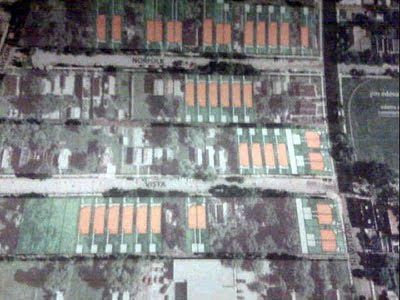 One of the worst aspects of this round of demolition was the wholesale removal of vacant frame houses like the row shown here. These six houses stood from 4452-4462 Vista Avenue. Proponents of demolition argued that the houses were too small for people's demands, and that wide clearance would allow for a large-scale new housing effort.
One of the worst aspects of this round of demolition was the wholesale removal of vacant frame houses like the row shown here. These six houses stood from 4452-4462 Vista Avenue. Proponents of demolition argued that the houses were too small for people's demands, and that wide clearance would allow for a large-scale new housing effort.
While the large-scale infill project is welcome fulfillment of the promises that the Development Corporation made in support of demolition, there remains some bittersweet irony that the houses now proposed for construction are small, one-story homes like those rejected as unfit for housing needs. Make no mistake, though -- the size of the proposed infill is perfect for the area and the housing needs. That's why some of us opposed demolishing the frame shotgun houses that also could have served those needs.
The wide demolition in 2006 could lead to two other losses, one of which is the prominent two-story brick corner building at Newstead and Vista that recent was being rehabilitated. Getting remaining buildings listed in the National Register of Historic Places to attain historic rehab tax credits might be difficult, although certainly not impossible. The demolitions are tentative, though, and could be avoidable.
One problem for these specific block of Adams Grove are the cul-de-sac street closures on the western end. These closures are partly responsible for the decline of the building stock in this area. Placement of the closures at an unsightly and moribund stretch of Taylor Avenue has compounded the ill effects. The "dead ends" on Swan, Norfolk and Vista avenues attract enough criminal activity to deserve the term.
Here's the closure on Norfolk:
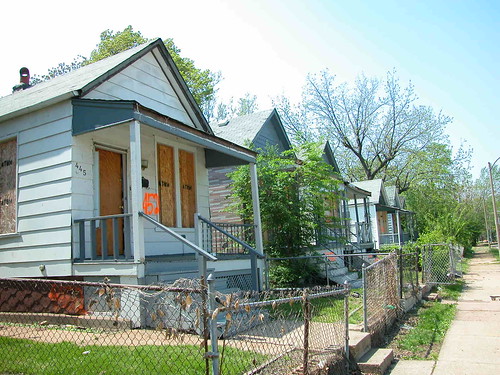
And this is Vista:
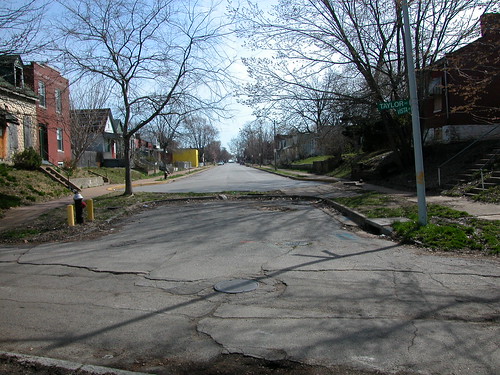
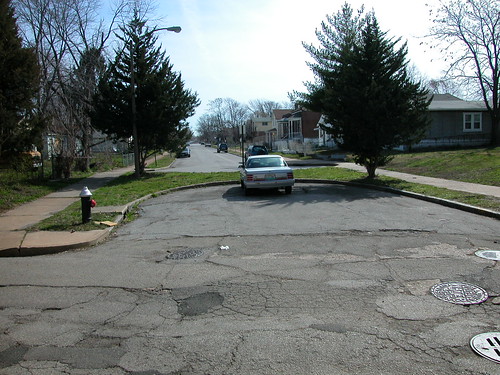 The Vista closure even has large evergreen trees that close off the sight lines of the street. To make these blocks safe and desirable places to live, the closures must be removed and Taylor must be improved. I want very much for the infill project to succeed, because Adams Grove needs major development. That development must address the circulation problem to succeed.
The Vista closure even has large evergreen trees that close off the sight lines of the street. To make these blocks safe and desirable places to live, the closures must be removed and Taylor must be improved. I want very much for the infill project to succeed, because Adams Grove needs major development. That development must address the circulation problem to succeed.
Readers may recall that in 2006, these blocks were targeted by the Forest Park Southeast Development Corporation during a wide round of demolition that took down over 30 buildings across the neighborhood. The Preservation Board approved demolition permits for one building on Norfolk and eight buildings on Vista.
 One of the worst aspects of this round of demolition was the wholesale removal of vacant frame houses like the row shown here. These six houses stood from 4452-4462 Vista Avenue. Proponents of demolition argued that the houses were too small for people's demands, and that wide clearance would allow for a large-scale new housing effort.
One of the worst aspects of this round of demolition was the wholesale removal of vacant frame houses like the row shown here. These six houses stood from 4452-4462 Vista Avenue. Proponents of demolition argued that the houses were too small for people's demands, and that wide clearance would allow for a large-scale new housing effort.While the large-scale infill project is welcome fulfillment of the promises that the Development Corporation made in support of demolition, there remains some bittersweet irony that the houses now proposed for construction are small, one-story homes like those rejected as unfit for housing needs. Make no mistake, though -- the size of the proposed infill is perfect for the area and the housing needs. That's why some of us opposed demolishing the frame shotgun houses that also could have served those needs.
The wide demolition in 2006 could lead to two other losses, one of which is the prominent two-story brick corner building at Newstead and Vista that recent was being rehabilitated. Getting remaining buildings listed in the National Register of Historic Places to attain historic rehab tax credits might be difficult, although certainly not impossible. The demolitions are tentative, though, and could be avoidable.
One problem for these specific block of Adams Grove are the cul-de-sac street closures on the western end. These closures are partly responsible for the decline of the building stock in this area. Placement of the closures at an unsightly and moribund stretch of Taylor Avenue has compounded the ill effects. The "dead ends" on Swan, Norfolk and Vista avenues attract enough criminal activity to deserve the term.
Here's the closure on Norfolk:

And this is Vista:

 The Vista closure even has large evergreen trees that close off the sight lines of the street. To make these blocks safe and desirable places to live, the closures must be removed and Taylor must be improved. I want very much for the infill project to succeed, because Adams Grove needs major development. That development must address the circulation problem to succeed.
The Vista closure even has large evergreen trees that close off the sight lines of the street. To make these blocks safe and desirable places to live, the closures must be removed and Taylor must be improved. I want very much for the infill project to succeed, because Adams Grove needs major development. That development must address the circulation problem to succeed.
Saturday, December 5, 2009
Good News Coming for Kiel Opera House?
 I found this 1950s postcard view of the Kiel Auditorium in my files today, and thought that I would share. The caption on the back of the postcard reads:
I found this 1950s postcard view of the Kiel Auditorium in my files today, and thought that I would share. The caption on the back of the postcard reads:The auditorium, outstanding among convention halls in the country, represents an investment of nearly $7,000,000. This beautiful structure contains an opera house; spacious exhibition hall; numerous smaller halls and committee rooms; and an extensive arena.
St. Louis, "The City of a Thousand Sights"
Of course, in 1992 the city began demolition of the Auditorium section, leaving the opera house, four auditoriums and part of the basement exhibition hall. However, what remains of the people's palace is still undeniably grand.
Last month, Dave Checketts told reporters that reopening the Kiel Opera House would be pushed off again, this time to spring 2011. Checketts and development partner McEagle Properties have had difficulty selling the $29 million in bonds issued by the city of St. Louis toward the projected $74 million renovation cost. There are rumors that bond sales may close by the end of this year.
Hopefully we'll get good news by year's end. Maybe soon there will be a new postcard celebrating the triumphant return of one of the city's finest landmarks of architecture and democratic accomplishment.
Labels:
downtown,
historic preservation
Friday, December 4, 2009
Legal Standing and Preservation in Pennsylvania
Today's Preservation Online includes an article that illustrates the importance of legal standing to historic preservation advocacy:
A last-ditch effort to save America's first Lithuanian Catholic church, located in Shenandoah, Pa., failed this week. Schuylkill County Judge Cyrus Palmer Dolbin ruled Dec. 1 that parishioners of St. George Catholic Church have "no standing," or no legal right, to file a lawsuit to halt the current demolition of the historic 1891 sanctuary.
There are familiar elements in the story: an unbending Catholic diocese, an inflated estimate of repair costs and wide support inside and outside of the Church for preservation. The plaintiffs are contemplating appeal, but demolition now has a green light to proceed no matter what the outcome of the appeal.
Of course, unlike the local effort of the Friends of the San Luis, the Shenandoah effort hinges on the basis that parishioners have standing to sue their own Diocese. What is clear is that having legally-defensible standing to bring forth lawsuits to halt demolition is crucial to preservation efforts. When the eleventh hour comes -- and it often does -- the courts provide recourse.
A last-ditch effort to save America's first Lithuanian Catholic church, located in Shenandoah, Pa., failed this week. Schuylkill County Judge Cyrus Palmer Dolbin ruled Dec. 1 that parishioners of St. George Catholic Church have "no standing," or no legal right, to file a lawsuit to halt the current demolition of the historic 1891 sanctuary.
There are familiar elements in the story: an unbending Catholic diocese, an inflated estimate of repair costs and wide support inside and outside of the Church for preservation. The plaintiffs are contemplating appeal, but demolition now has a green light to proceed no matter what the outcome of the appeal.
Of course, unlike the local effort of the Friends of the San Luis, the Shenandoah effort hinges on the basis that parishioners have standing to sue their own Diocese. What is clear is that having legally-defensible standing to bring forth lawsuits to halt demolition is crucial to preservation efforts. When the eleventh hour comes -- and it often does -- the courts provide recourse.
Labels:
historic preservation,
public policy
Thursday, December 3, 2009
Depletion, West Evans Avenue
 This summer and fall, brick thieves have destroyed four houses on the 4200 block of West Evans Avenue in the Vandeventer neighborhood. Shown above are three of the houses, the privately-owned 4219 W. Evans (left) and the Land Reutilization Authority-owned 4207 (center) and 4203 (right) W. Evans Avenue. Across the street are the remains of the privately-owned house at 4202 W. Evans Avenue.
This summer and fall, brick thieves have destroyed four houses on the 4200 block of West Evans Avenue in the Vandeventer neighborhood. Shown above are three of the houses, the privately-owned 4219 W. Evans (left) and the Land Reutilization Authority-owned 4207 (center) and 4203 (right) W. Evans Avenue. Across the street are the remains of the privately-owned house at 4202 W. Evans Avenue.
This block is located in the city's Fourth Ward, which is represented by Alderman Sam Moore (Democrat). Moore has been vigilant in trying to keep brick thieves out of his ward, as he explains in a 2007 video produced for Pub Def by Antonio French.
Labels:
brick rustling,
northside,
vandeventer
Tuesday, December 1, 2009
Raise a Cup for Preservation
Next Friday, unwind with your fellow preservationists over a pint of fresh keg beer -- while helping to raise money for your right to stand up to senseless demolition!

On Friday, December 11, local preservationists will host another Anti-Wrecking Ball to raise funds for ongoing legal efforts. Darren Snow, host of KDHX’s "Rocket 88" program, is the DJ for the party. All who attend will be entered into a raffle for prizes from STL Style, St. Louis Cinemas and other local businesses. The venue will be a new community gallery in Old North St. Louis in the heart of the nearly-completed 14th Street redevelopment project.
When: Friday, December 11 from 8:00 p.m. - midnight.
Where: Old North St. Louis Community Gallery, 2700 N. 14th Street
Cost: $10 (includes beer)
The Anti-Wrecking Ball will raise funds for the ongoing appeal of this year’s ruling by St. Louis Circuit Court Judge Robert Dierker that citizens have no standing under city preservation law.
When the Preservation Board approved -- by a close 3-2 vote -- demolition of the modern San Luis Apartments in June, the Friends of the San Luis filed an injunction in court. Under city preservation law, the citizens who make up Friends of the San Luis have a right to appeal – but only after a demolition permit has been issued! The Friends sued to stop demolition so we could appeal the Preservation Board ruling.
However, Judge Dierker ruled against the Friends, and not because he thought their argument was wrong, but because he thinks that citizens who are not owners of property threatened with demolition should have no right to protest or appeal. The San Luis Apartments were demolished this summer, but the ruling left a bigger issue that affects all citizens regardless of what they think about that one particular building.
Unchallenged, Dierker’s ruling could impede citizen efforts to save community landmarks across the city. The Friends of the San Luis filed an appeal to the Missouri Court of Appeals in September to stand up for future preservation efforts. The Friends of the San Luis believe that citizen rights should not be demolished along with the San Luis Apartments.
Consequently, the Friends of the San Luis and other preservationists have organized the Anti-Wrecking Ball to raise funds to cover attorney’s fees. After the Friends wins its appeal, the Anti-Wrecking Ball movement will continue to raise money for legal costs associated with citizen preservation action.

On Friday, December 11, local preservationists will host another Anti-Wrecking Ball to raise funds for ongoing legal efforts. Darren Snow, host of KDHX’s "Rocket 88" program, is the DJ for the party. All who attend will be entered into a raffle for prizes from STL Style, St. Louis Cinemas and other local businesses. The venue will be a new community gallery in Old North St. Louis in the heart of the nearly-completed 14th Street redevelopment project.
When: Friday, December 11 from 8:00 p.m. - midnight.
Where: Old North St. Louis Community Gallery, 2700 N. 14th Street
Cost: $10 (includes beer)
The Anti-Wrecking Ball will raise funds for the ongoing appeal of this year’s ruling by St. Louis Circuit Court Judge Robert Dierker that citizens have no standing under city preservation law.
When the Preservation Board approved -- by a close 3-2 vote -- demolition of the modern San Luis Apartments in June, the Friends of the San Luis filed an injunction in court. Under city preservation law, the citizens who make up Friends of the San Luis have a right to appeal – but only after a demolition permit has been issued! The Friends sued to stop demolition so we could appeal the Preservation Board ruling.
However, Judge Dierker ruled against the Friends, and not because he thought their argument was wrong, but because he thinks that citizens who are not owners of property threatened with demolition should have no right to protest or appeal. The San Luis Apartments were demolished this summer, but the ruling left a bigger issue that affects all citizens regardless of what they think about that one particular building.
Unchallenged, Dierker’s ruling could impede citizen efforts to save community landmarks across the city. The Friends of the San Luis filed an appeal to the Missouri Court of Appeals in September to stand up for future preservation efforts. The Friends of the San Luis believe that citizen rights should not be demolished along with the San Luis Apartments.
Consequently, the Friends of the San Luis and other preservationists have organized the Anti-Wrecking Ball to raise funds to cover attorney’s fees. After the Friends wins its appeal, the Anti-Wrecking Ball movement will continue to raise money for legal costs associated with citizen preservation action.
Labels:
events
A City Guarantee for Northside Regeneration
At the November 13 ceremonial signing of the first ordinances related to the Northside Regeneration redevelopment concept, Mayor Francis Slay made statements to St. Louis Post-Dispatch reporter Tim Logan that indicated his former hard line against a public guarantee of any of the $390 million in tax increment financing bonds authorized by one of the ordinances. Northside Regeneration's developer, Paul J. McKee, Jr., has told the press on numerous occasions that the project won't work without a public guarantee of some kind. Slay and Deputy Mayor Barbara Geisman have assured the public that City Hall was not eager to support such a guarantee.
Yet on November 13, Slay told Logan that there "may be some limited participation" from city government. He followed that statement up with an ambiguous one: "To what extent, if any, the city is going to do that hasn't been determined."
It should be determined in one word: No.
At least, the City of St. Louis should not pledge its full faith and credit to cover any of the bonds for the Northside Regeneration TIF. For one thing, the city simply cannot afford the liability. In the last two weeks, the press has reported several stories about a $20 million city budget shortfall and mandatory city employee furloughs. It's not fair to ask city employees to take a hit and then be open to handing a private developer the right to bankrupt the city. Even a $1 million guarantee is too much risk for a city government trying to avoid a giant deficit.
Precedent for city guarantee shows high risk and poor development outcomes. Our first foray was backing the bonds for Midland Group's $53 million St. Louis Marketplace on Manchester Road, completed in 1991. The developers sold the city on the promise that reclaiming the old Scullin Steel site -- a true brownfield -- for the sort of retail center found all over St. Louis County would lead to a sales tax boon. That promise rang hollow, and revenue fell short of the projection used to sell the TIF. The city has paid $3 million toward the TIF for the Marketplace, and will pay another $1,3 million before the TIF expires in 2011. The St. Louis Marketplace has high vacancy and low demand for its spaces.
Next, in 2003 the city backed bonds issued for the Renaissance Grand Hotel & Suites on Washington Avenue downtown. This time, developers Historic Restoration, Inc. and a subsidiary of Kimberly-Clark Corporation didn't sell the vision to the city, but capitalized on the mythic promise that St. Louis desperately needed a giant convention hotel to compete for major conventions. The hotel has never met revenue and occupancy projections, and $13.6 million from federal block grants to St. Louis have been used to cover shortfalls.
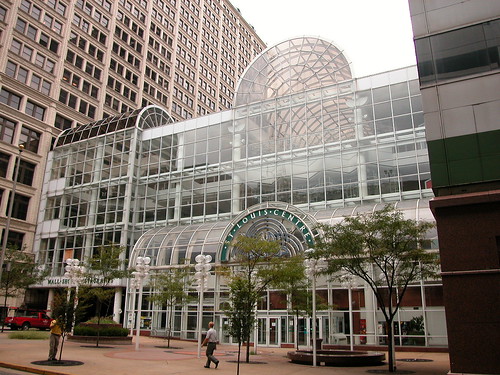 Most recent and most irresponsible was the city's decision to guarantee bonds for Pyramid's $26 million purchase of One City Centre in 2006. Time will tell how bad the damage to city coffers will be. Currently, the city is trying to work out a plan to keep the office tower profitable by converting the surrounding St. Louis Centre mall into parking to serve tenants. With the prospect of being on the hook for the bonds, the city has no time to wait to consider more creative ideas for reusing the old mall.
Most recent and most irresponsible was the city's decision to guarantee bonds for Pyramid's $26 million purchase of One City Centre in 2006. Time will tell how bad the damage to city coffers will be. Currently, the city is trying to work out a plan to keep the office tower profitable by converting the surrounding St. Louis Centre mall into parking to serve tenants. With the prospect of being on the hook for the bonds, the city has no time to wait to consider more creative ideas for reusing the old mall.
Some might argue that Northside Regeneration is too different from past city-guaranteed projects to be compared. However, fundamentally, the project shares a lot in common with the three other projects: the "last great hope" myth surrounding the project, the unrealistic revenue projections and the developer using public process to lure private capital to the project. The truth is that the Northside Regeneration project is so malleable and undefined that any revenue projections created right now are just fancy guesstimates. I write this with some hope, because the malleability of the project makes it more possible to reconcile McKee's vision with community needs.
The reconciliation of McKee's private aims and the civic life of north St. Louis is exactly where some help from city government would come in handy. If City Hall and the Board of Aldermen want to commit resources to speed along redevelopment, there are appropriate ways of doing so that are fairly noncontroversial: roads, streets, sidewalks and parks. There are service needs in the footprint of McKee's Northside project that should be addressed now -- especially in those parts of the project McKee has phased as the last areas to get development.
One project that the city could try to fund early on are stabilization and marketing of Land Reutilization Authority buildings in the project area, so that historic buildings are preserved and ready-to-rehab buildings are available for microdevelopers and rehabbers. Another project that would be of great benefit to all citizens is restoration and enhancement of St. Louis Place Park. DeSoto Park and others need improvements as well. And the area's sidewalk network is badly damaged. These are all improvements that have been needed for a long time, and are promised in the Northside Regeneration presentation. Why not start them now?
Public sector expenditure can be used to make the near north side a better place for current residents. McKee will realize benefits too, of course, but not at the expense of the people his plan is supposed to help. The city guarantee that needs to be on the table is a guarantee that residents of the near north side will benefit from the redevelopment project, enjoy an improved quality of life and have their tax dollars used for true public benefit.
Yet on November 13, Slay told Logan that there "may be some limited participation" from city government. He followed that statement up with an ambiguous one: "To what extent, if any, the city is going to do that hasn't been determined."
It should be determined in one word: No.
At least, the City of St. Louis should not pledge its full faith and credit to cover any of the bonds for the Northside Regeneration TIF. For one thing, the city simply cannot afford the liability. In the last two weeks, the press has reported several stories about a $20 million city budget shortfall and mandatory city employee furloughs. It's not fair to ask city employees to take a hit and then be open to handing a private developer the right to bankrupt the city. Even a $1 million guarantee is too much risk for a city government trying to avoid a giant deficit.
Precedent for city guarantee shows high risk and poor development outcomes. Our first foray was backing the bonds for Midland Group's $53 million St. Louis Marketplace on Manchester Road, completed in 1991. The developers sold the city on the promise that reclaiming the old Scullin Steel site -- a true brownfield -- for the sort of retail center found all over St. Louis County would lead to a sales tax boon. That promise rang hollow, and revenue fell short of the projection used to sell the TIF. The city has paid $3 million toward the TIF for the Marketplace, and will pay another $1,3 million before the TIF expires in 2011. The St. Louis Marketplace has high vacancy and low demand for its spaces.
Next, in 2003 the city backed bonds issued for the Renaissance Grand Hotel & Suites on Washington Avenue downtown. This time, developers Historic Restoration, Inc. and a subsidiary of Kimberly-Clark Corporation didn't sell the vision to the city, but capitalized on the mythic promise that St. Louis desperately needed a giant convention hotel to compete for major conventions. The hotel has never met revenue and occupancy projections, and $13.6 million from federal block grants to St. Louis have been used to cover shortfalls.
 Most recent and most irresponsible was the city's decision to guarantee bonds for Pyramid's $26 million purchase of One City Centre in 2006. Time will tell how bad the damage to city coffers will be. Currently, the city is trying to work out a plan to keep the office tower profitable by converting the surrounding St. Louis Centre mall into parking to serve tenants. With the prospect of being on the hook for the bonds, the city has no time to wait to consider more creative ideas for reusing the old mall.
Most recent and most irresponsible was the city's decision to guarantee bonds for Pyramid's $26 million purchase of One City Centre in 2006. Time will tell how bad the damage to city coffers will be. Currently, the city is trying to work out a plan to keep the office tower profitable by converting the surrounding St. Louis Centre mall into parking to serve tenants. With the prospect of being on the hook for the bonds, the city has no time to wait to consider more creative ideas for reusing the old mall.Some might argue that Northside Regeneration is too different from past city-guaranteed projects to be compared. However, fundamentally, the project shares a lot in common with the three other projects: the "last great hope" myth surrounding the project, the unrealistic revenue projections and the developer using public process to lure private capital to the project. The truth is that the Northside Regeneration project is so malleable and undefined that any revenue projections created right now are just fancy guesstimates. I write this with some hope, because the malleability of the project makes it more possible to reconcile McKee's vision with community needs.
The reconciliation of McKee's private aims and the civic life of north St. Louis is exactly where some help from city government would come in handy. If City Hall and the Board of Aldermen want to commit resources to speed along redevelopment, there are appropriate ways of doing so that are fairly noncontroversial: roads, streets, sidewalks and parks. There are service needs in the footprint of McKee's Northside project that should be addressed now -- especially in those parts of the project McKee has phased as the last areas to get development.
One project that the city could try to fund early on are stabilization and marketing of Land Reutilization Authority buildings in the project area, so that historic buildings are preserved and ready-to-rehab buildings are available for microdevelopers and rehabbers. Another project that would be of great benefit to all citizens is restoration and enhancement of St. Louis Place Park. DeSoto Park and others need improvements as well. And the area's sidewalk network is badly damaged. These are all improvements that have been needed for a long time, and are promised in the Northside Regeneration presentation. Why not start them now?
Public sector expenditure can be used to make the near north side a better place for current residents. McKee will realize benefits too, of course, but not at the expense of the people his plan is supposed to help. The city guarantee that needs to be on the table is a guarantee that residents of the near north side will benefit from the redevelopment project, enjoy an improved quality of life and have their tax dollars used for true public benefit.
Subscribe to:
Posts (Atom)

